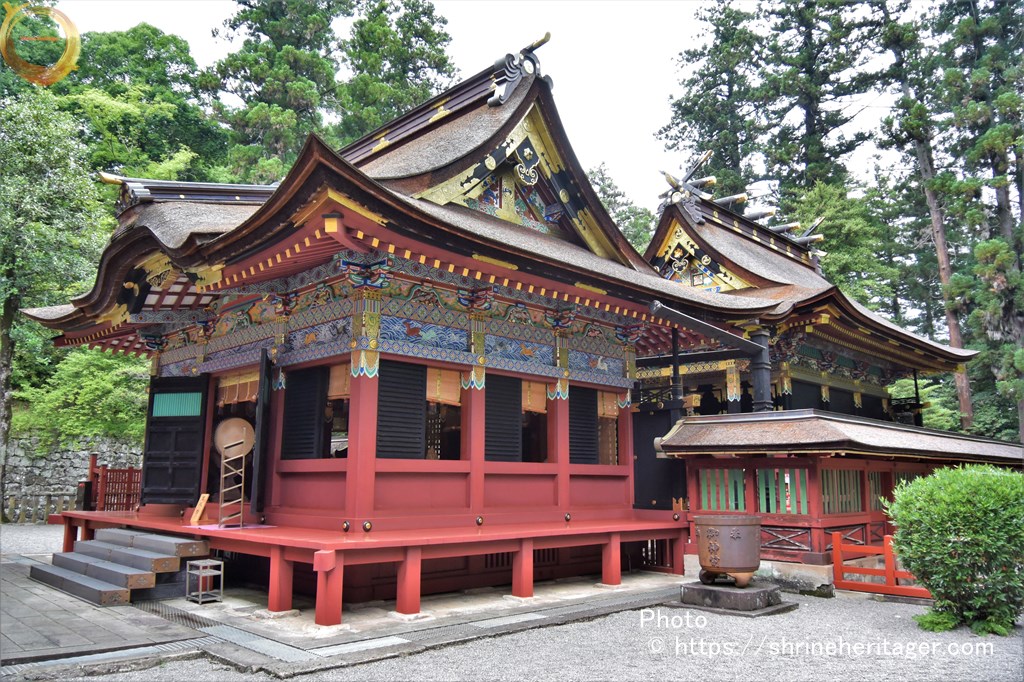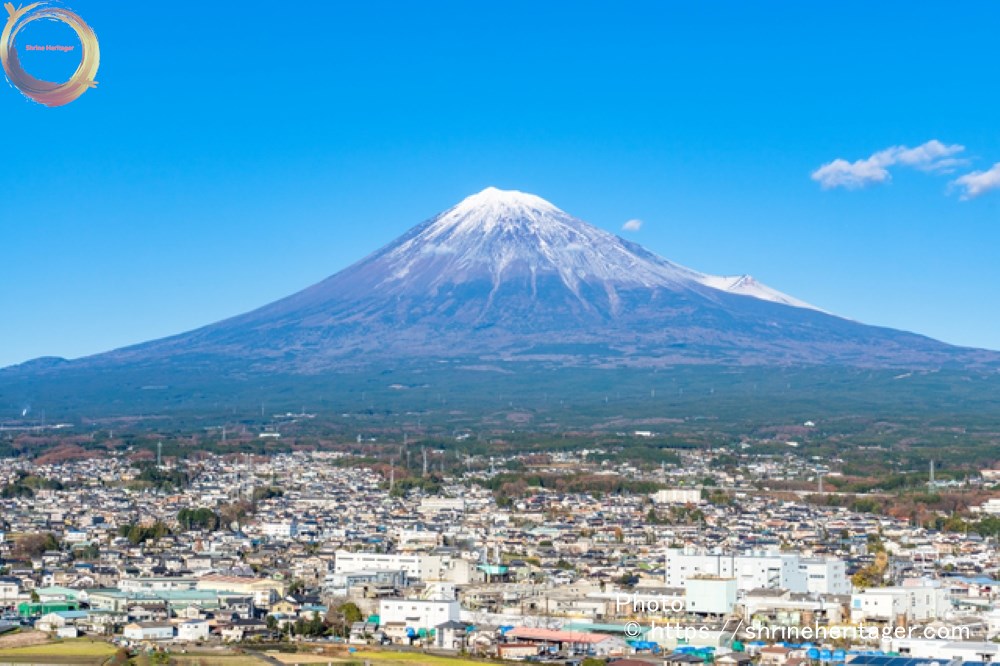For worship, once go up the approach from the south side and go through the Otorii. A flat approach leads to the main gate, drawing an arc. Then, from there, there is a steep descending stone step, and the shrine is built right below. Up, flattening, and then down. Go to the shrine on a “down road” that is very rare in Japan. The building was built by "shogun Tokugawa (徳川将軍) ".It is gorgeous.
目次
- 1 1.ご紹介(Introduction)
- 2 この神社の予備知識(Preliminary knowledge of this shrine)
- 3 Visit the Shrine (Pray at the Shrine)
- 4 神社の伝承(Old tales handed down to shrines)
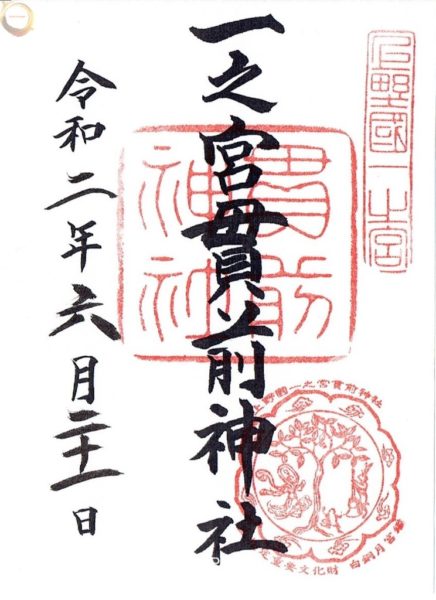
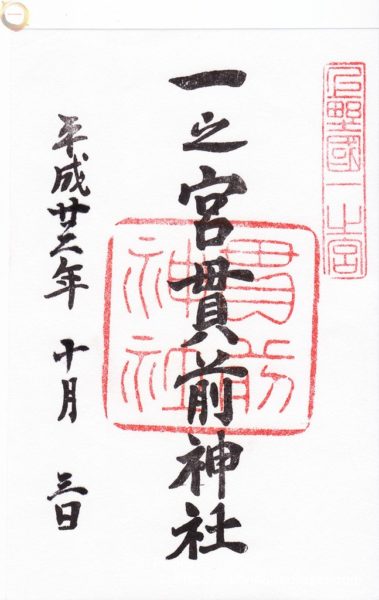
1.ご紹介(Introduction)
The official name of this shrine and how to be called The present address and map I will introduce the history of the god and the shrine enshrined.
【神社名(shrine name)】
一之宮 貫前神社(ichinomiya nukisaki shrine)
(いちのみや ぬきさきじんじゃ)
[通称名(Common name)]
【鎮座地 (location) 】
Ichinomiya, Tomioka City, Gunma Prefecture, Japan
[地 図 (Google Map)]
【御祭神 (God's name to pray)】
《主》経津主神(futsunushi no kami)
《配》姫大神(hime no okami)
【御神格 (God's great power)】(ご利益)
【格 式 (Rules of dignity) 】
・『延喜式神名帳(engishiki jimmeicho)』所載社
・ 上野国一之宮
・ 別表神社
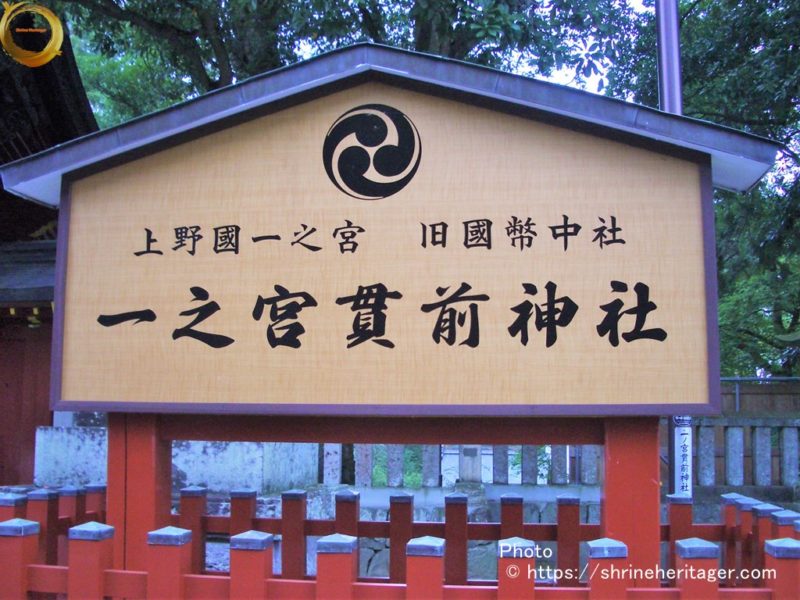
【創 建 (Beginning of history)】
A historical note distributed by the shrine
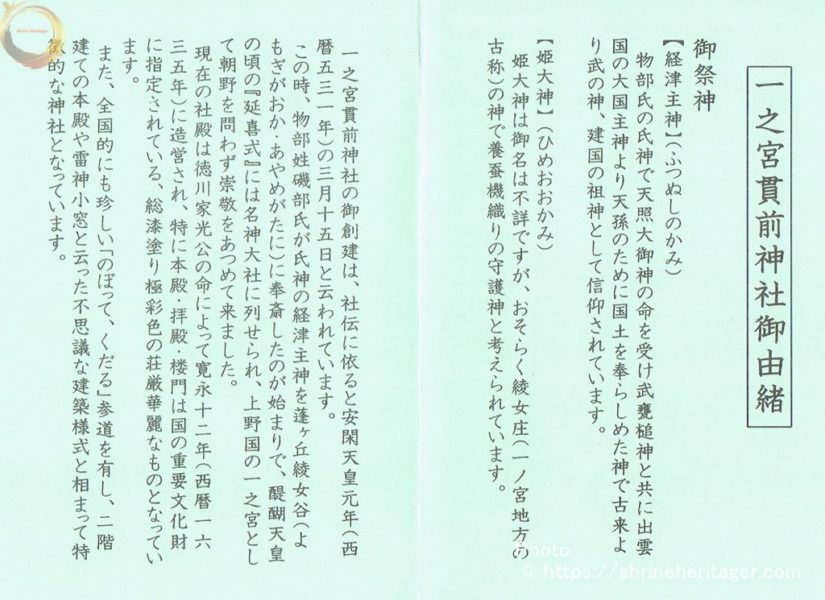
【由 緒 (history)】
Ueno Kuniichinomiya, Former Prefectural Mint Nakasha, Ichinomiya Kanzen Shrine, Ichinomiya Jinza, Tomioka City, Gunma Prefecture.
As it has been sung in the Warabe song for a long time, Ichinomiya Kanzen Shrine is a shrine in Ueno province, and it is believed and loved by people in the distance as well as the prefecture as a god of good luck, security, agriculture, machinery, marriage, and good luck, and the god of safe production. The shrine is located in a scenic spot that faces the clear stream of the River, the railway line in the north, the rice in the south, the chichibu mountain range, and the mountain range of The Kanzu Arabun to the west, climbing the small hill, and passing through the large torii gate of Tanuri which looks up. It has a form that is unusual in the whole country of going down the approach of the north slope, and the shrine hall of the total lacquered colorful color is surrounded by a dense forest and is skillfully arranged, and it is a gorgeous thing like seeing toering palace of Nikko, It is called small sunlight.
御祭神 経津主神、姫大神。
Jedutsu is the son of the two gods of The Tsutsuo and The Tsutsu-onna, and it is a god of the founding which is good as The Master of The Buddha of Ikinasai, and is a god of the founding which consulted with the great power lord of Izumo province (Shimane Prefecture) with the order of the heavenly sun keisuke son came to our country, and dedicated the land for the heavenly grandchild.Hime-Ogami is unknown to the god of the festival, and is probably considered to be the guardian deity of sericulture machine loave in the Ijomejo (the ancient name of the Ichinomiya region).
Venerable
According to the company biography, Mr. Isobe, the chief priest of The Usui District, visited the coast of the Southern Seaside, and established a residence in The Onamiya, The First Emperor's Yasukan, on March 15, 1995.
There is a dedication of the first time on March 15, 2010, emperor Tenmu Hakuho, and it is written again every time the Shinto position rises, and it is written in the collection of the collection of the duke of Rakujo in the imperial amount.
It is known that there were a lot of offerings etc. especially worshipful by the samurai family and the local family in the samurai age, and there was a dedication article etc. from the okukata party, and the belief of the goddess was also strong in the rule of The Emperor Daigo and the Enki, and it was a rule of The Emperor Of Daigo, and the worship of Asano was enshrined as the Onenomiya of Ueno Province, and it came to the samurai era.
In the 4th year of Meiji, he was established in the National Mint Nakasha.
In 1946, due to the abolition of the corporate system, it was called Ichinomiya Kanzen Shrine.During this time, the shrine will be treated to the shrine in the event of a one-dynasty state emergency, such as the visit of the royal family, such as the worship of the royal family.
Shrine hall and precincts
For the current shrine,
It was renovated at the order of Tokugawa 3rd Shogun Iemitsu, and was built in 12 years (about 330 years ago).
In 11 years, the former 祿, the fifth Shogun Tsunayoshi made a major repair, and not only was the total lacquered and splendid splendid structure of the early Edo period, but its structure was designated as an important cultural property (formerly a national treasure) because of its unique point, which is called the so-called pre-construction.
It can be said that the shrine, the tower gate, and the east-west corridor are the architecture of the same age, and it can be said that it is in the road that the carpenter of the Tokugawa family completes the world-class art building called Nikko Temple.The precincts are
In the forest of about 26,000 tsubo, there is a sacred tree of about 1200 years of trees in the back of the main shrine, and it is said that it is also known as Iina Fujitagi in the old days, Fujiwara Hidego (Saito Tahidego) is said to have planted several or so 36 annuals with a prayer for victory, and now only one sacred tree remains.
The west gate is the site of the Imperial Palace of the Shikinen Sengu Festival, and the gate in the east is the site of the monastery of the old Shinto shrine and the buddhist buddhist style era, and the torii gate in the unknown gate where there is the ruins of Kannon dodo, the three-story pagoda, the bell tower, etc. is said to have been in the place of the imperial torii gate far south in the old days.Treasures
There are more than 400 works, including mirrors and armor, as well as works that are sufficient to talk about ancient reverence beliefs such as sacred clothes, ancient documents, and kagura surfaces.
It is prized in metalwork art as what can be seen through the mirror, a hundred dozen sides, Nara, Heian, Kamakura, Muromachi, Yoshino, Momoyama, and Edo periods,
The one specified in the inner heavy sentence is as follows.
This work was written about 2000 years ago.
About 360 years ago, around 3 years ago, the nanny dedication of Obata Takechiyo, Umezaku pattern copper mirror,
About 760 years ago, in the Kamakura period, Taketora-patterned copper mirror,
About 500 years ago, the Muromachi period. God's clothing, more than 60 remaining, new dedication every Sengu since Genwa 9 years.※See from "National Shrine Festival Comprehensive Survey (1995)" [Shrine Main Office]
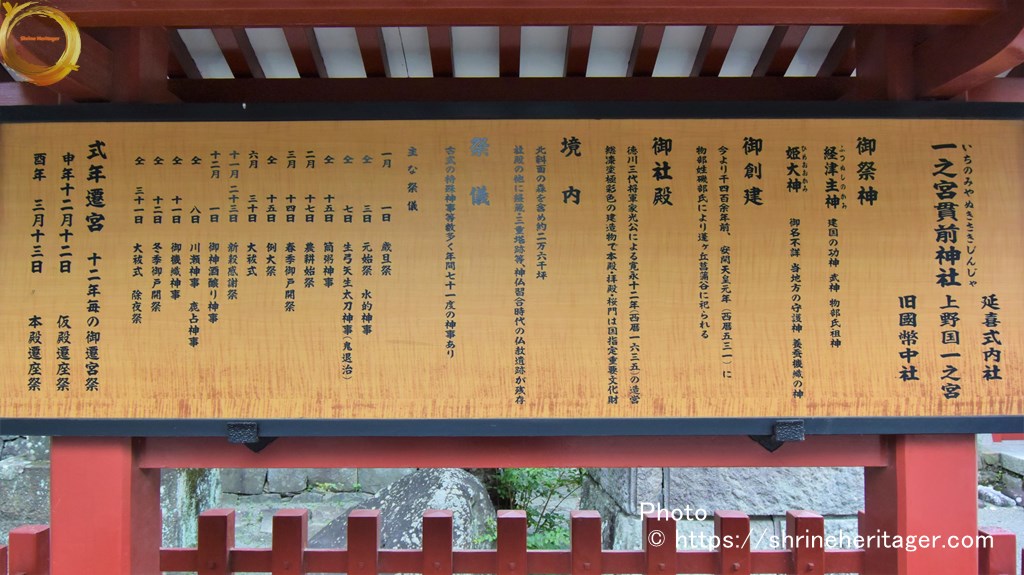
【境内社 (Other deities within the precincts)】
本殿向かって左脇に鎮座
・抜鉾若御子神社(nukihokowakamiko shrine)
《主》経津主命御子
※元は一ノ宮字若宮に鎮座 明治38年に現在地に遷座
The 27th Generation of Emperor Ankan (531-535) was founded.
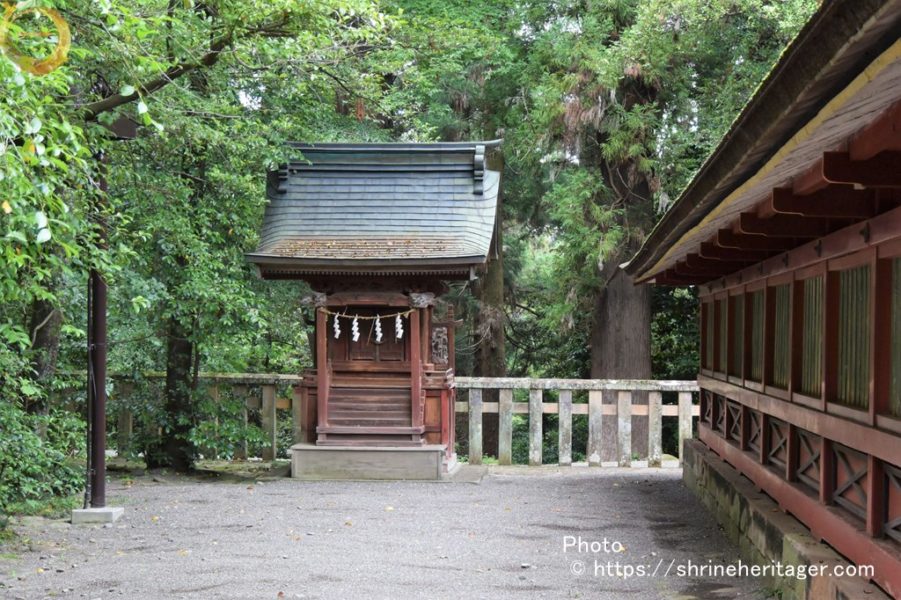
In the middle ofthe stone steps down from the main gate to the tower gate, tsukikan Shrine (headquarters before Kan'ei 12 years old is used as the shrine hall)
At the time of The God and Buddha Xiai, it is a moon reading shrine worshipping the moon night viewing life in the Meiji period at the time of The God and Buddha Xiai.
《主》月夜見命
《合》御嶽之神・大雷神・大日孁命・豊宇気毘売神・大穴牟遅神
八衢比古神・建御名方神・八坂刀売命・菅原道真公
猿田毘古神・宇迦之御魂神・大宮能売命・品陀和気命
少名毘古那神・近戸神
※明治41年 社久司神社(秋畑琵琶澤)・雷電神社(秋畑二ツ石)・湯前神社(秋畑裏根)・近戸神社(富岡市野上)の近在4社を合祀

仮殿敷地に隣接に鎮座
・内宮(寛永12年 現在地に遷宮)
《主》天照皇大神
・外宮(寛永12年 現在地に遷宮)
《主》豊受大神
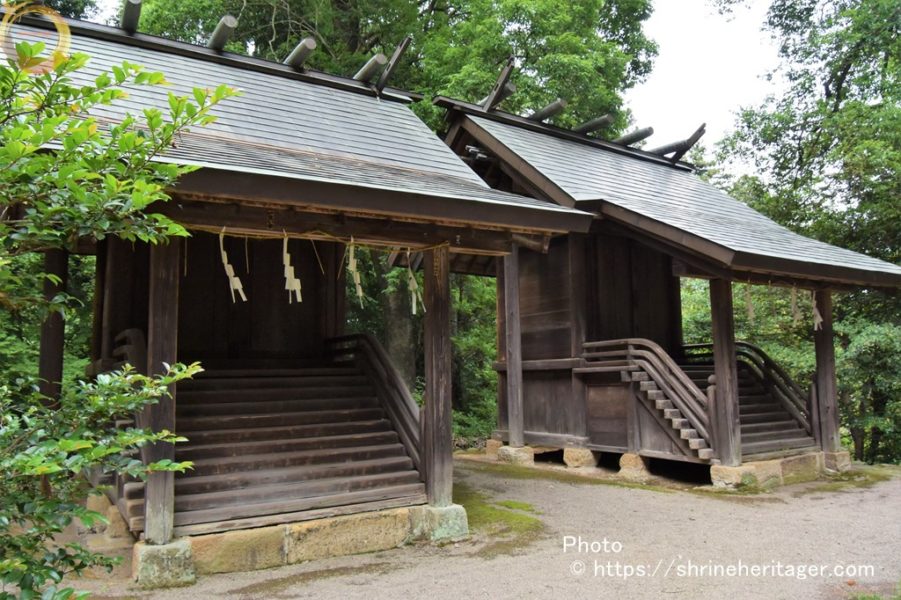
・日枝神社
《主》大己貴命・大山咋命
《合》建御名方命・八坂刀売命・豊受姫命・火産霊命・菅原道真公
稲倉魂命・木花咲耶姫命・伊邪那岐命・伊邪那美命・大物主命
宇迦之御魂命・波迩夜須毘売命・大山津見命・大日孁命
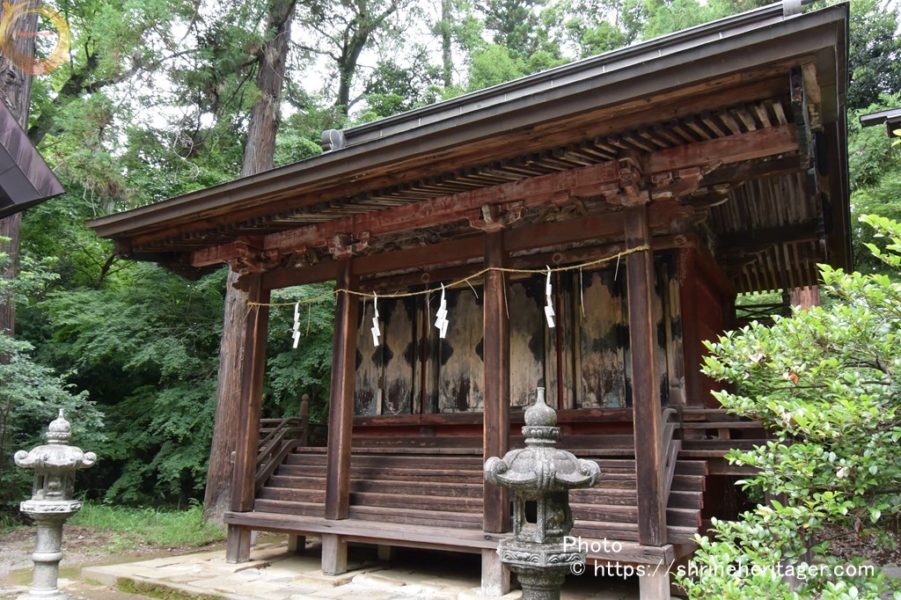
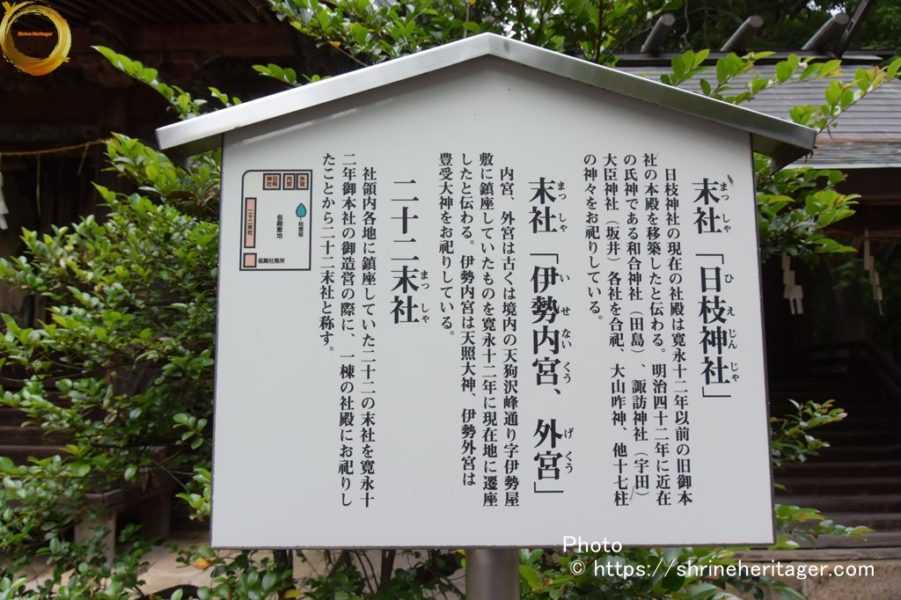
・日枝神社・外宮・内宮は並んで鎮座します
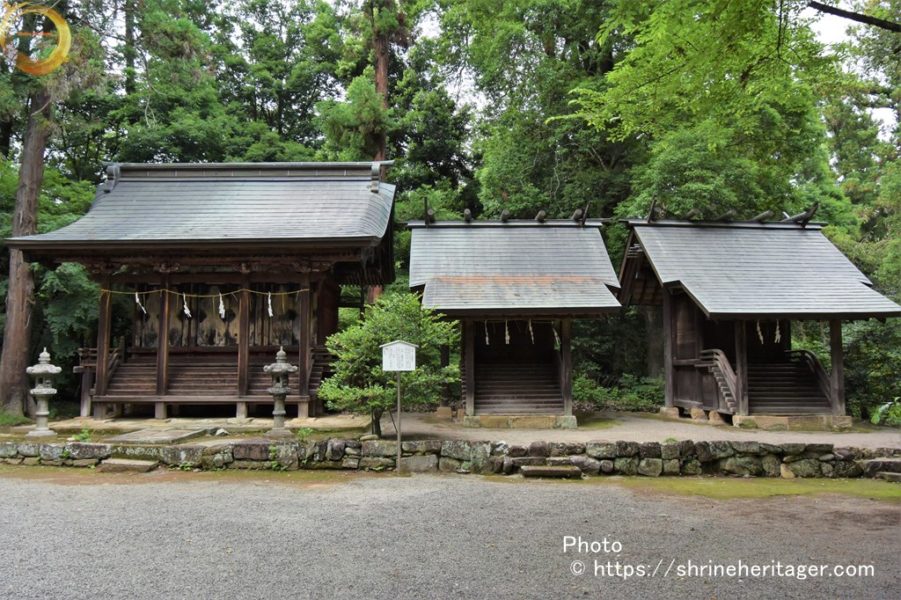
・二十二社
社領内に祀られていた各社を 寛永12年の造営時に一棟にまとめたと伝わります
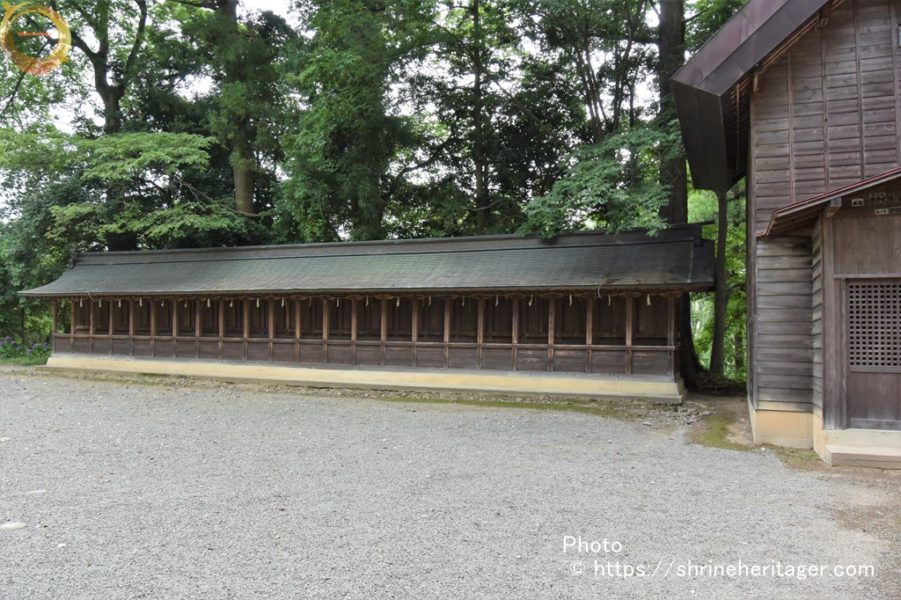
・八坂神社
《主》素盞嗚命(susanowo no mikoto)
7月17日にお詣りの際には 総門に 末社 八坂神社祭御旅所 が斎行されていました
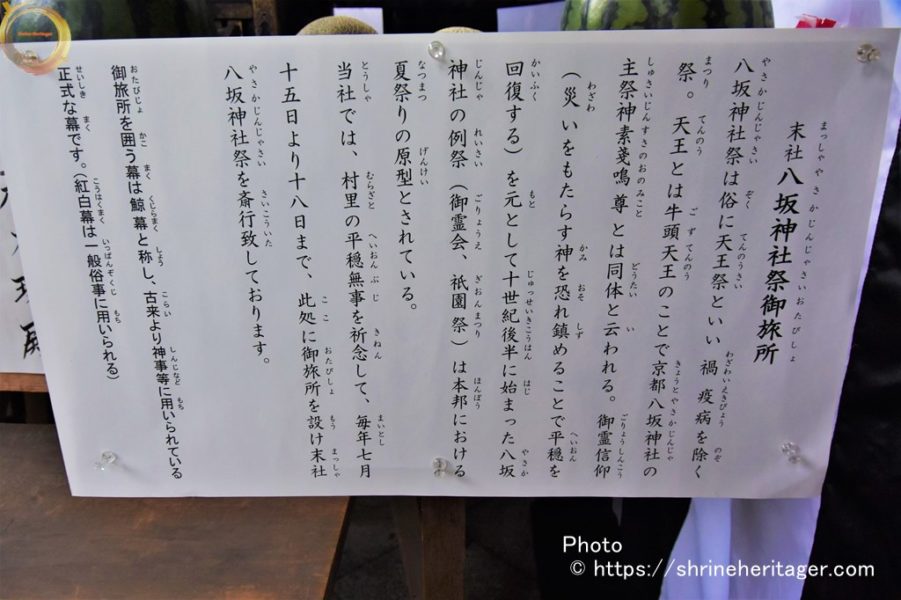
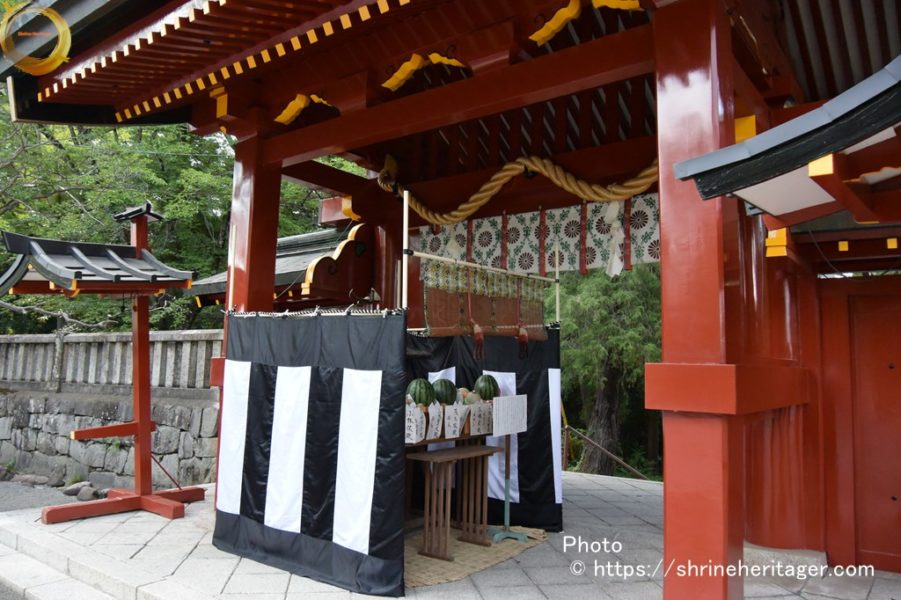
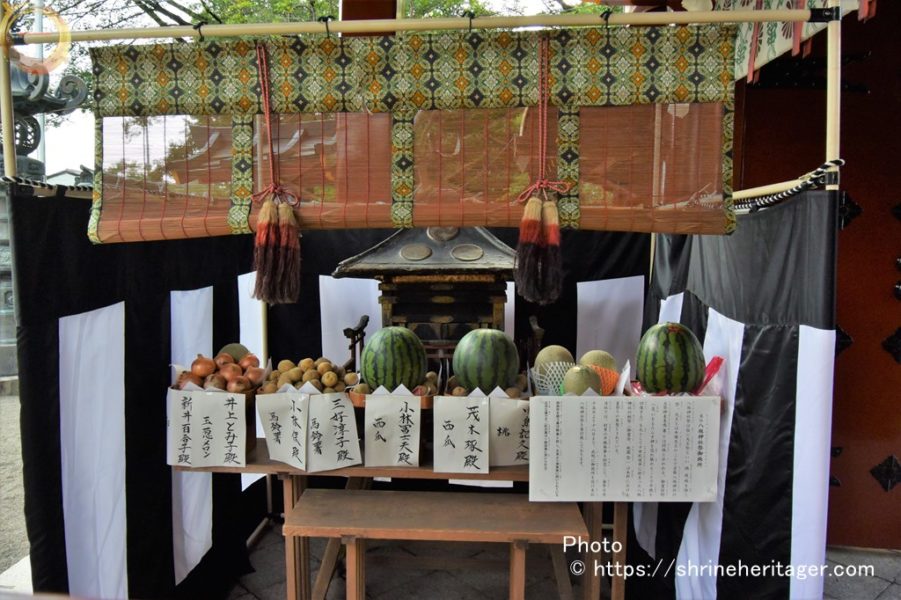
スポンサーリンク
この神社の予備知識(Preliminary knowledge of this shrine)
This shrine has a long history.
『延喜式神名帳(engishiki jimmeicho)』The two volumes that are regarded as important among all 50 ritual- style scrolls created by the Imperial Court during the middle Heian period are called " engishiki jimmeicho " (edited in December 927). Approximately 1100 years ago, the name of "2861 company" and the number of gods enshrined there are listed in the list of government offices (shikinaisha) nationwide.
【延喜式神名帳】(engishiki jimmeicho)The shrine record was completed in December 927 AD.
[旧 行政区分](Old administrative district)
(God's seating number) Higashiyamado 382 seats... Large 42 (including monthly Shinjo 5) and small 340
[旧 国 名 ](old county name)
(神様の鎮座数)上野国 12座(大3座・小9座)
[旧 郡 名 ](old region name)
(神様の鎮座数)甘楽郡 2座(大1座・小1座)
[名神大 大 小]Ceremony Meishin Taisha 式内 名神大社
[旧 神社名 ] 貫前神社(名神大)
[ふ り が な ](ぬきのさきの かみのやしろ)
[How to read] (nukino sakino kamino yashiro)
https://www.digital.archives.go.jp/DAS/meta/listPhoto?LANG=default&BID=F1000000000000004146&ID=M2014101719562090086&TYPE=&NO= Image Use
National Diet Library Digital Collection Enki-shiki Publication (Baba) [Former Kurashi] Autumn Leaves Yama Bunko
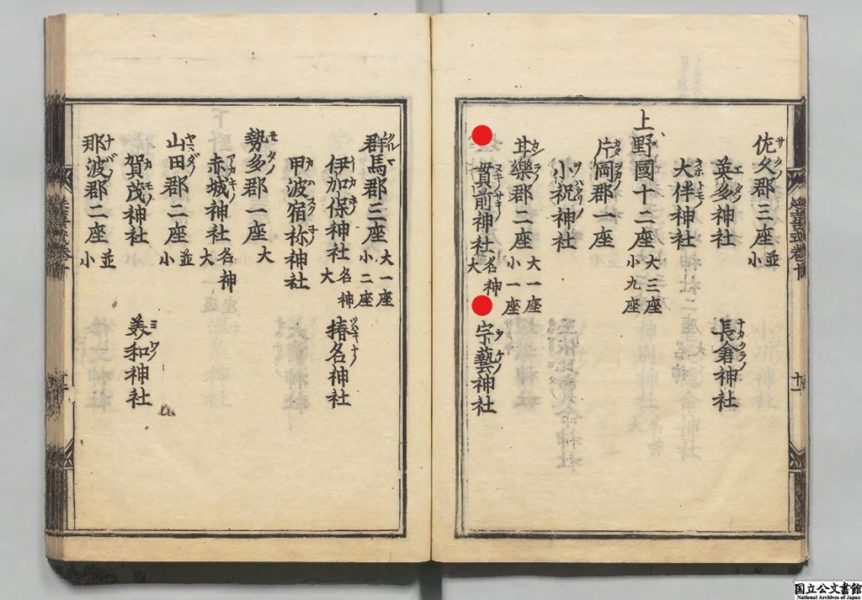
[Otaky Point] (Points Selected by Japan Otaku)
I will introduce the preliminary knowledge that you will be interested in this shrine from a otaku's point of view.
About "The shrine of the descent visit" which is rare in the whole country of Kanzen Shrine
It's a shrine that goes up, flattens, and now goes down, a shrine that is rare in japan.
Approach to the approach
From Omotesando to Otorii, Omotesando goes up the stone steps.
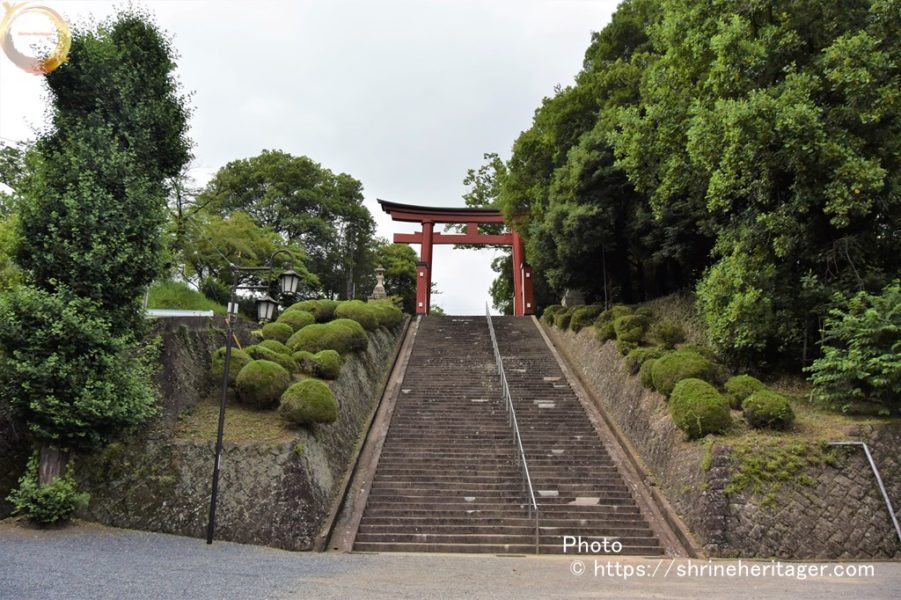
Flat approach
It is at the same height from the large torii gate to the main gate, and the flat Omotesando continues like an arc.
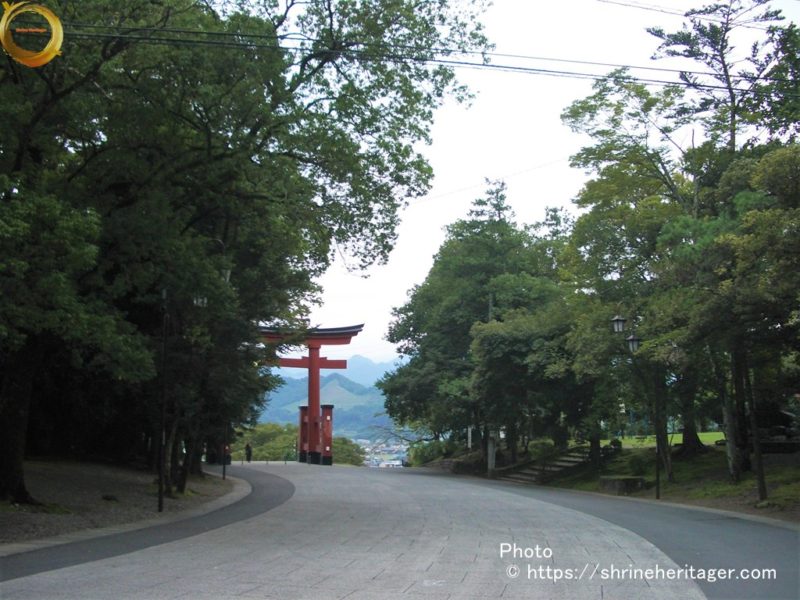

The approach to the descent
From the main gate to the tower gate and the shrine hall, Omotesando goes down the stone steps.
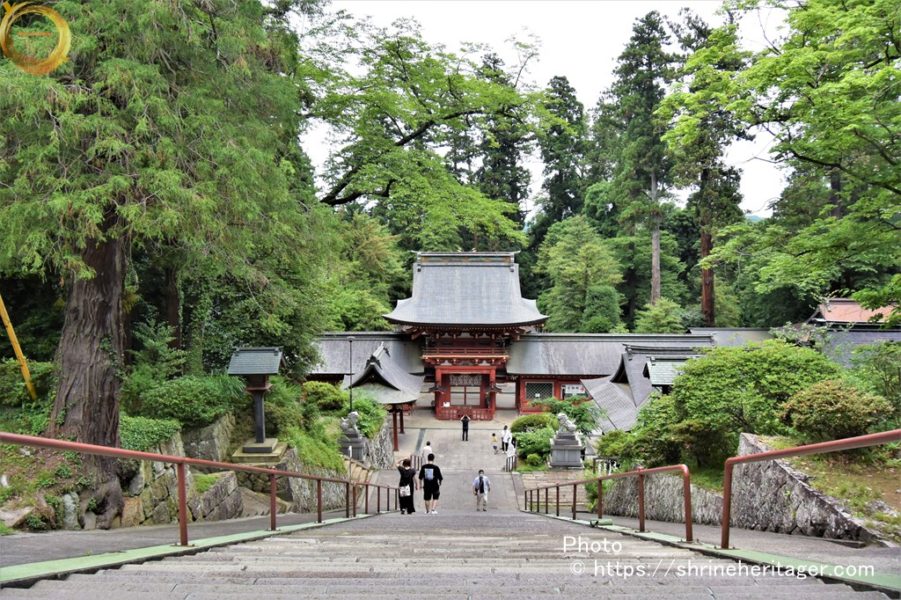
More about Setsushi, Suesha and Maenomiya
Bordering Setsha
Arafune Shrine (arafune shrine) "Lord" Jetsu Lord Life
As the origin of the god of the mountain, there is "Shintoshu" with Sasaokayama (Arafuneyama)
Please see the article of Arafune Shrine which is said to be the outer setsha of Kanzen Shrine.
・稲含神社(inafukumi shrine)《主》宇迦之御魂命
Please see the photograph that "Raijin small window" in the main hall of the head office is facing Mt. Ina, and look at it (please enlarge it and see the small window of the second floor part of the center of the main hall)

境外末社・小船神社(kobune shrine)《主》経津主命
It is said that it is the head office's exodus, and it is said that it is a seat further to the north in old days.
"The Origin Book of the Edo Period" enshrines one of the two boats that Ichinomiya Daimigami rode from Tengu
Please see the article of Ofune Shrine which is said to be the exorcism of Kanzen Shrine.
貫前神社の前宮(旧鎮座地)
・咲前神社(sakisaki shrine)《主》経津主命 ・大己貴命 ・保食命
According to the company biography, three pillars of "Lightning Ashiseki" are now in the first year of Emperor Ankan (534) that it was the land of the present-day Sakimae Shrine that was camped when he went to Arafuneyama on the border of Ueno and Shinano provinces in order to conquer the kenshin mekata life. , in the first year of Hakuho (650), when Asabe Asaomi was built in
the Imperial Court, the main life of Keitsu was transferred to Rengaoka Iris Valley in Kanraku-gun by a oracle, and it became the seat of Ueno Kuni Ichinomiya Kanukimae Shrine. となった
Please see the article of Sakimae Shrine which is regarded as the maenomiya (former jinzachi) of Kanzen Shrine.
スポンサーリンク
Visit the Shrine (Pray at the Shrine)
I introduce the state when I visited this shrine.
Get off at Kamishu Ichinomiya Station and walk 15 minutes
Turn right at Prefectural Road No. 198 and go up the approach to the square with a parking lot.
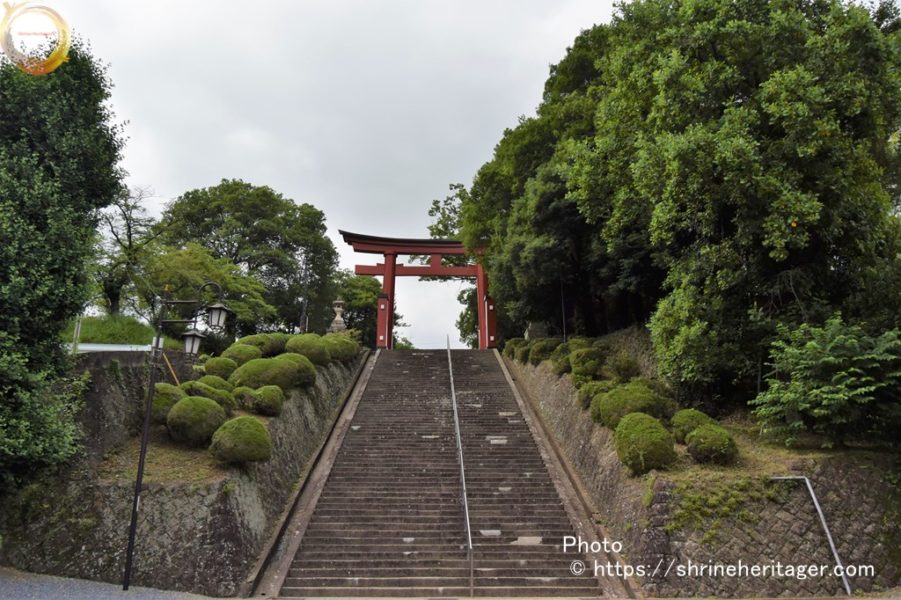
Arrived at Ichinomiya Kanzen Shrine (ichinomiya yukisaki shrine)
Go up the stone steps, bow and pass through the large torii gate
From the large torii gate, a flat approach leads to the main gate in an arc.
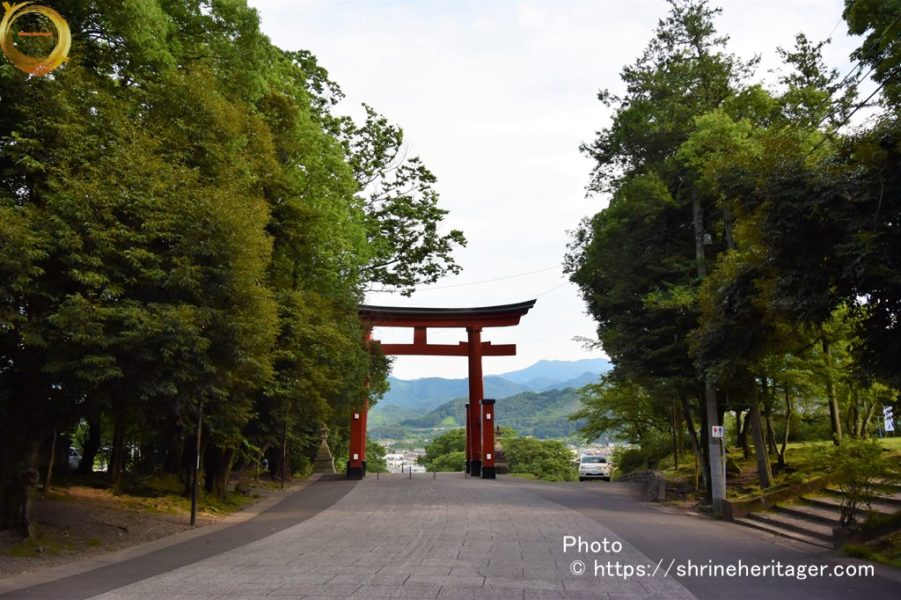
In front of the main gate, keio 2nd year (1866) donation (1544 local sericulture farmers, silk merchants of Kamishu, Edo, and Yokohama) A splendid 395cm high "Karado lantern" was built seven years later, and the Tomioka Paper Factory opened seven years later.
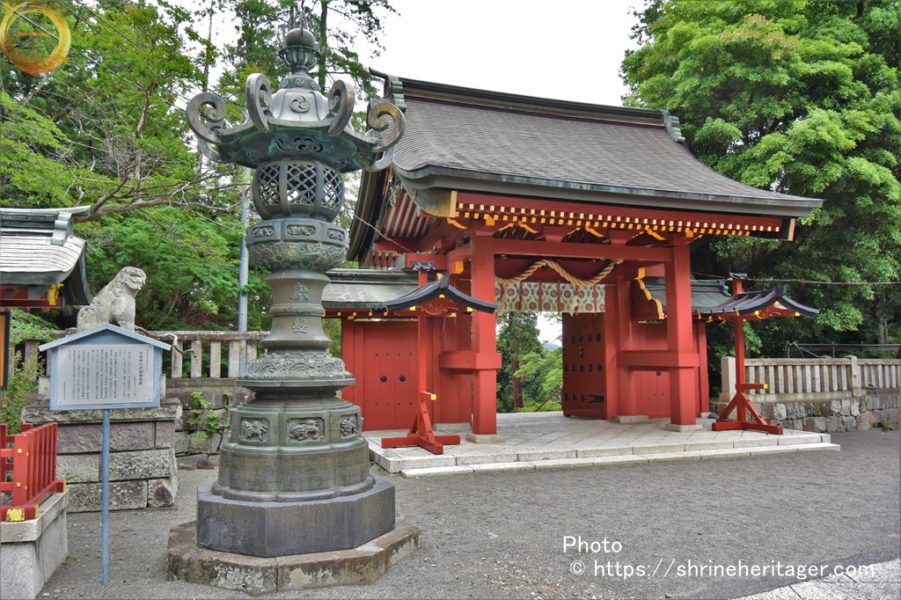
Beyond that, a unique Komainu sits.
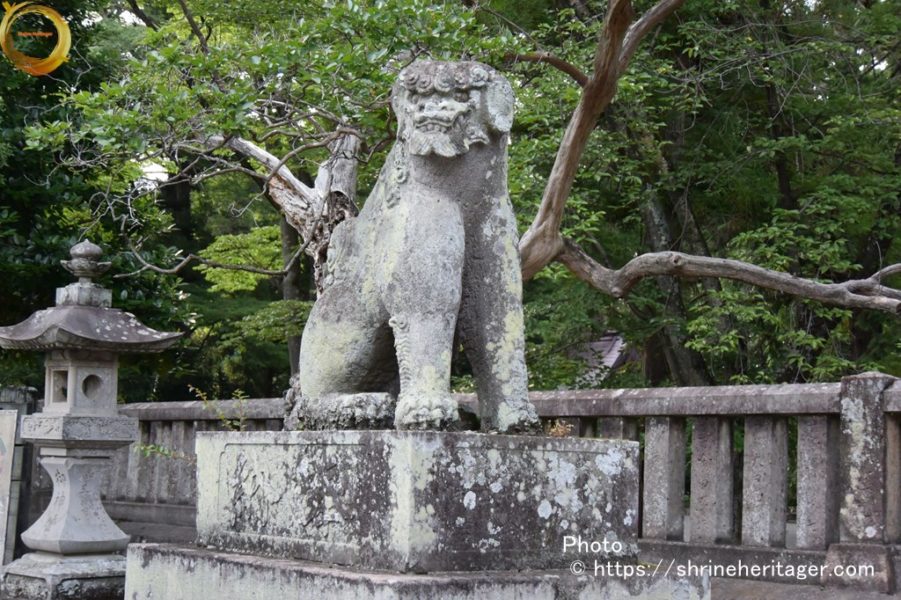
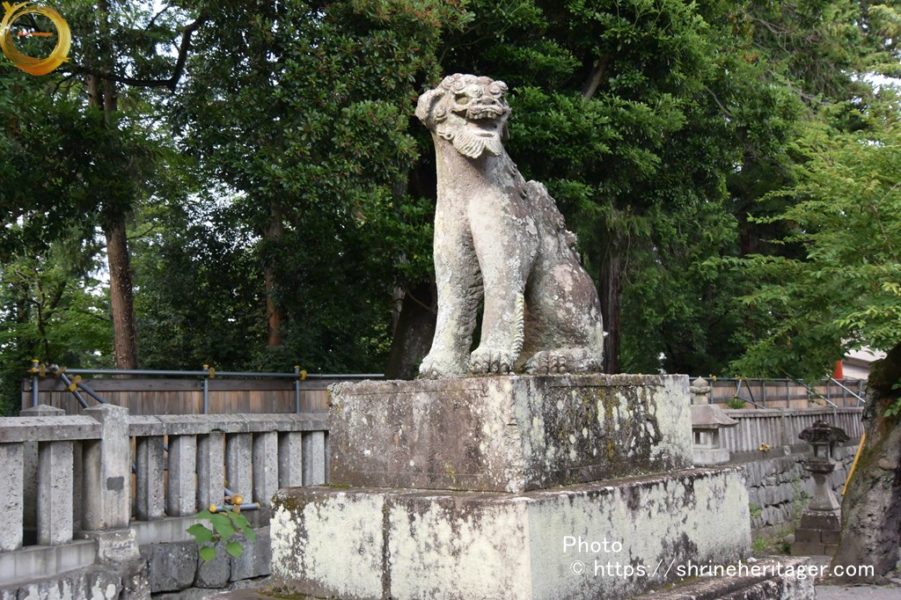
There is a history guide board, too, and it reads and it indulges.
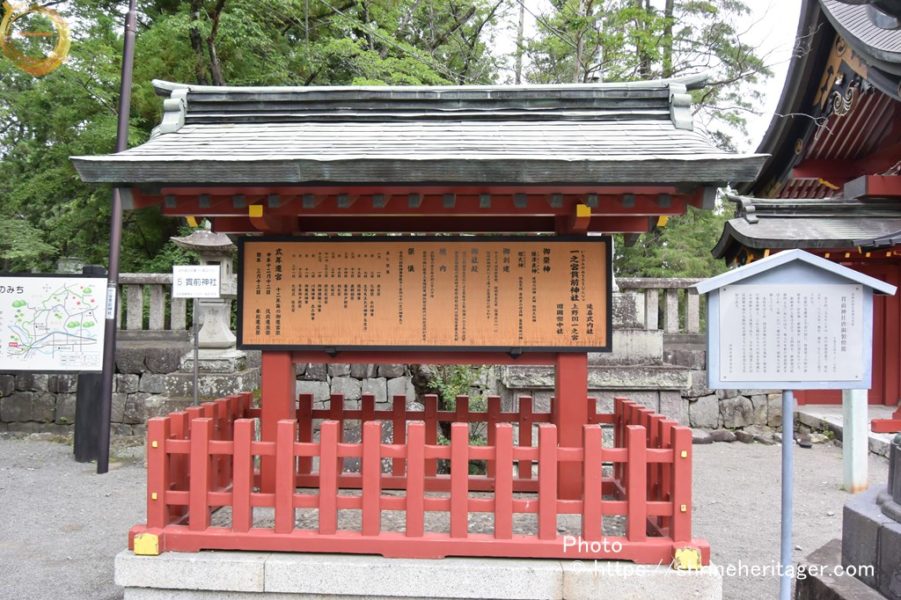
When you bow and pass through the main gate, you'll see a tower gate far below, not in front of you.
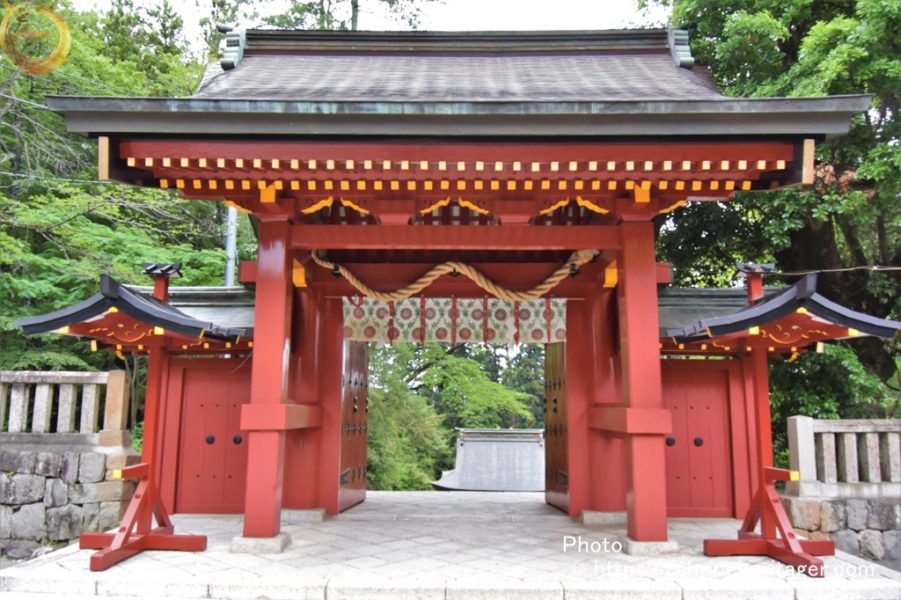
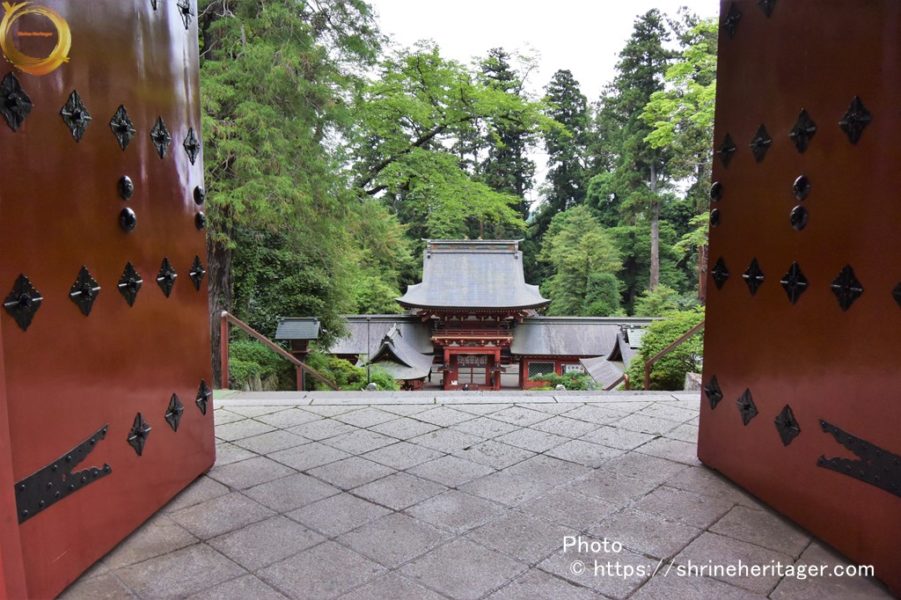
The stone steps of the steep descent continue, and it is surprised at the descent approach.
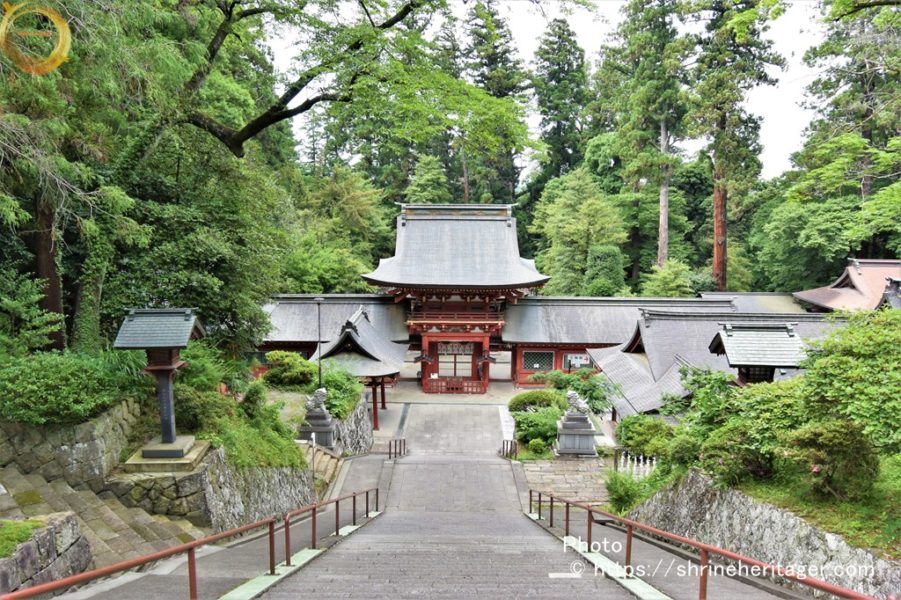
On the way down the approach to the stone steps, on the left is a temporary hall site (the ceremony year Sengu is held every 12 years at Kanzen Shrine, and a temporary hall is built on the temporary hall site), and the shrine sits later.
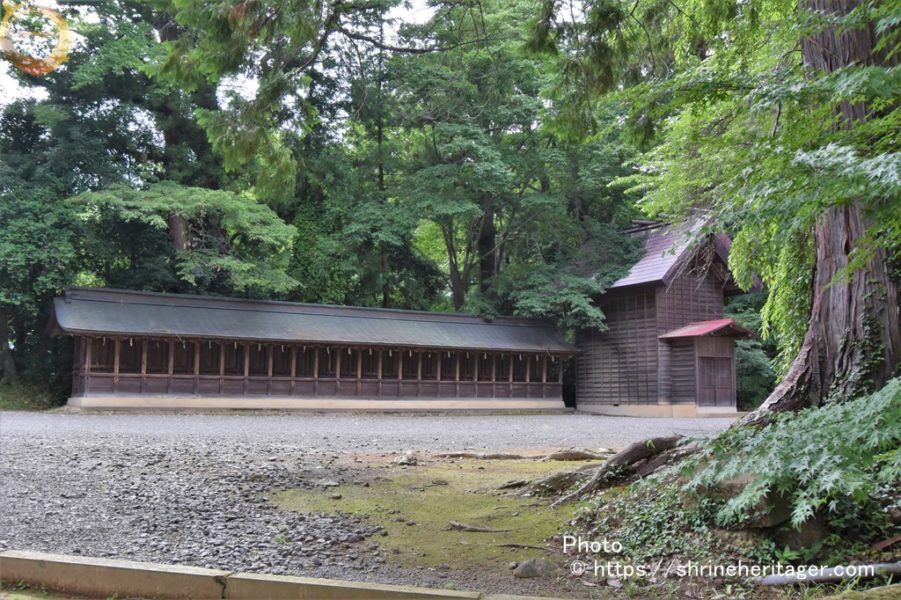
If you go down the stone steps further, you will find "Saikan" on your right.

There is a shrine on the left to face you.
・月読神社(寛永12年以前の本社 旧拝殿を社殿としています)
《主》月夜見命
《合》御嶽之神・大雷神・大日孁命・豊宇気毘売神・大穴牟遅神
八衢比古神・建御名方神・八坂刀売命・菅原道真公
猿田毘古神・宇迦之御魂神・大宮能売命・品陀和気命
少名毘古那神・近戸神
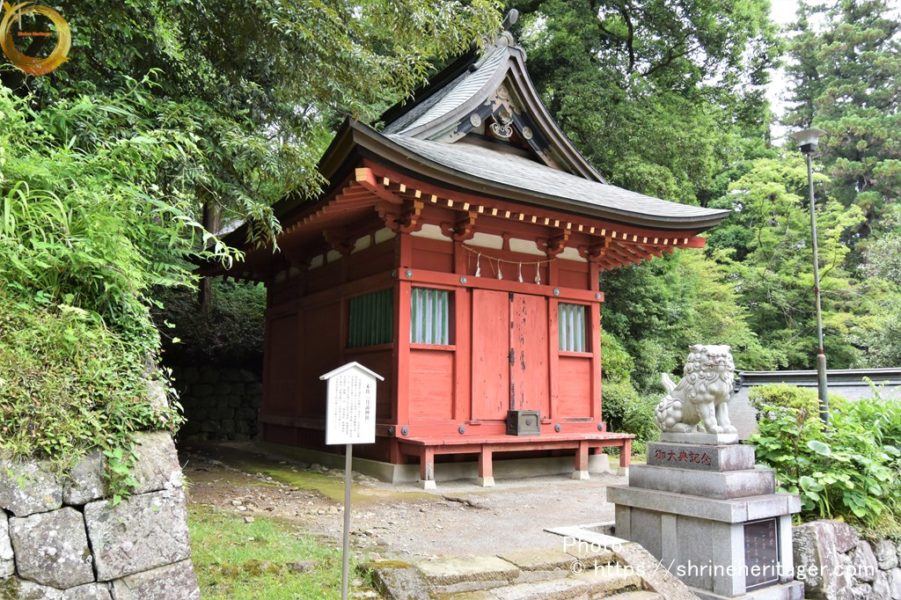
There's a tower gate under the stone steps, and there's a temizusha on the left.
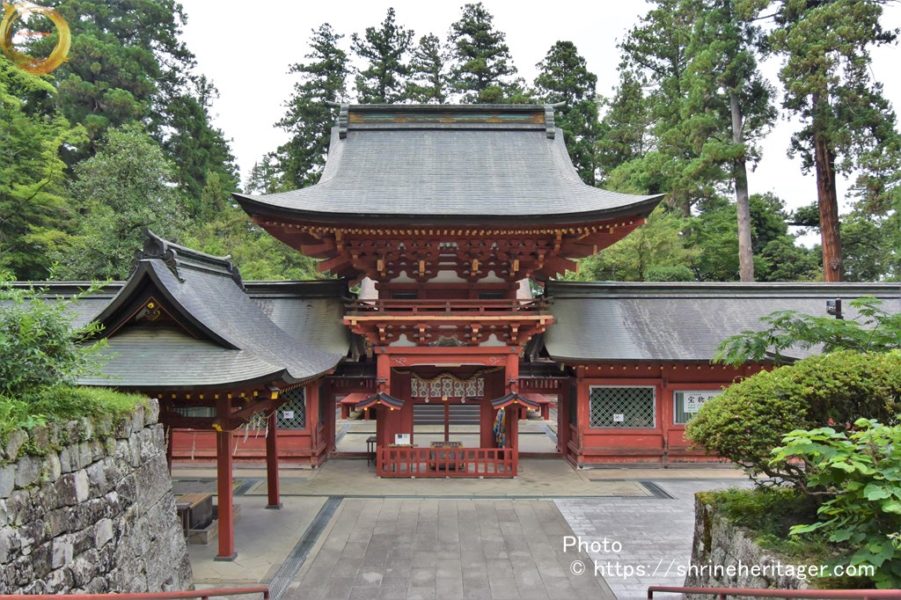
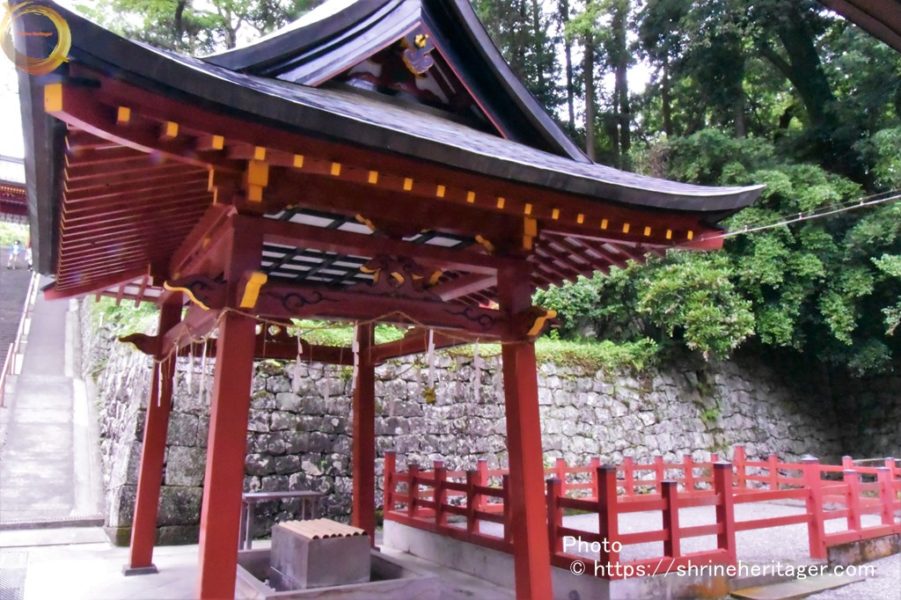
There's a coin box at the gate, and you'll be here.
Give me a prayer.
When you reach the god of worship, where you worship God's power, pray with your hands together.
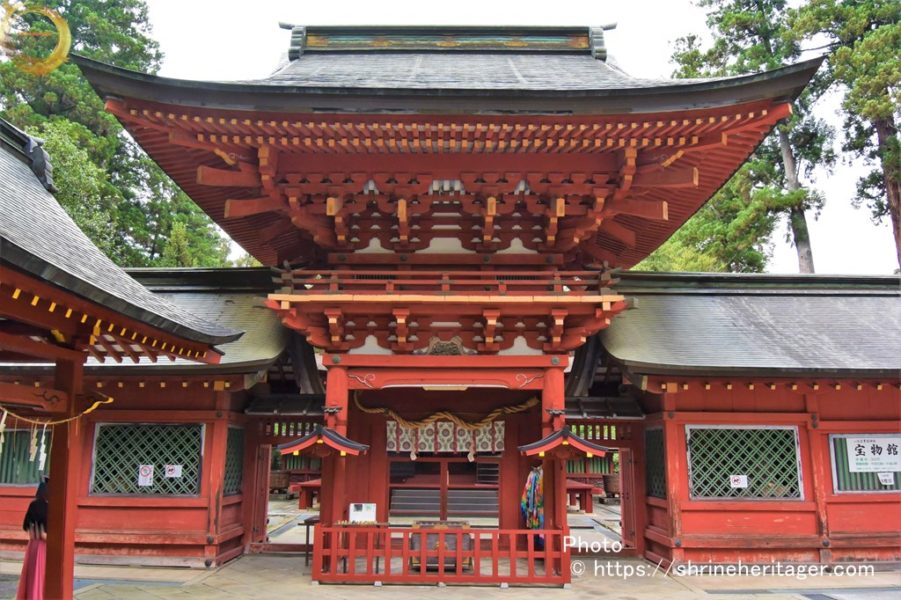
It surrounds the sanctuary with a tower gate and a corridor, but the door is liberated and it goes to the shrine.
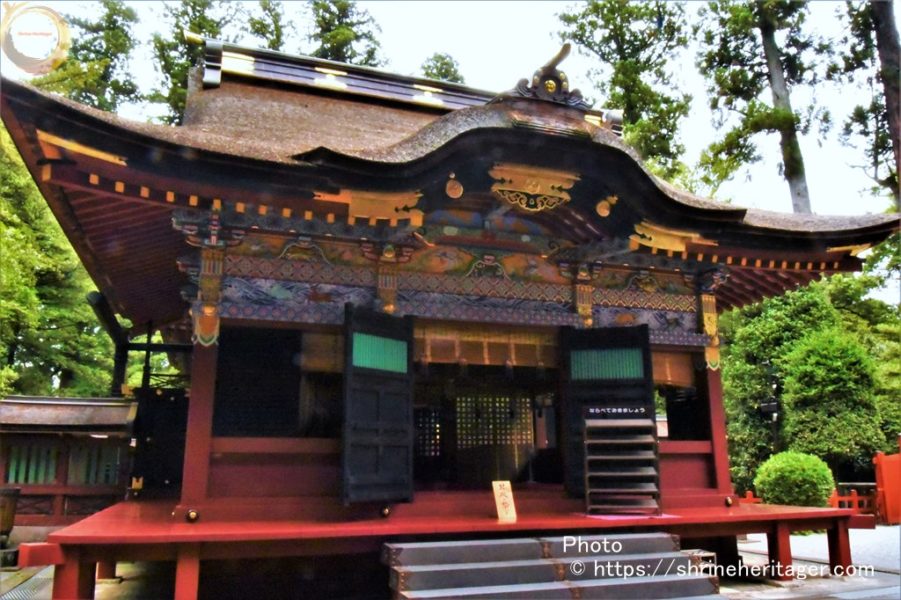
The shrine is very splendid, but the founders are the same, and the main hall, worship hall, tower gate, and corridor are built by Tokugawa Iemitsu, the 3rd Shogun (1635).
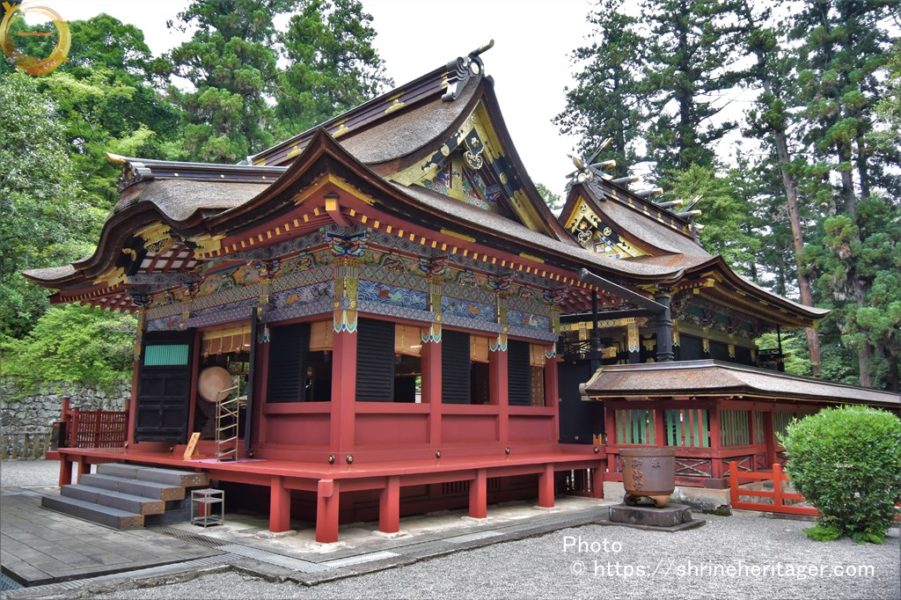
Genroku 11 (1698) It is said that the 5th Shogun Tsunayoshi's large-scale repair was painted with colorful lacquer and it became a splendid construction of the present day.
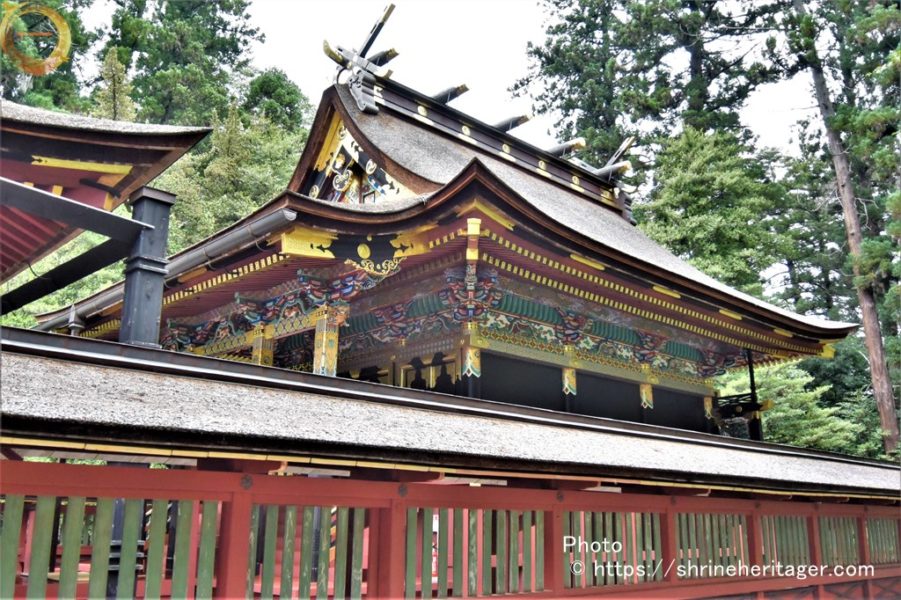
The main hall, worship hall, tower gate, and corridor are all designated as important cultural properties of the country
many of the giraffes are drawn.
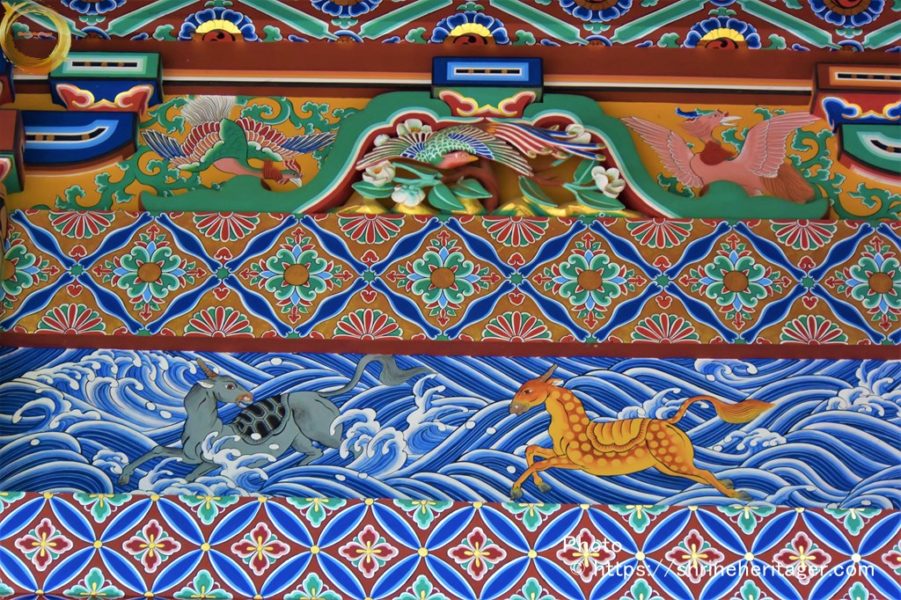
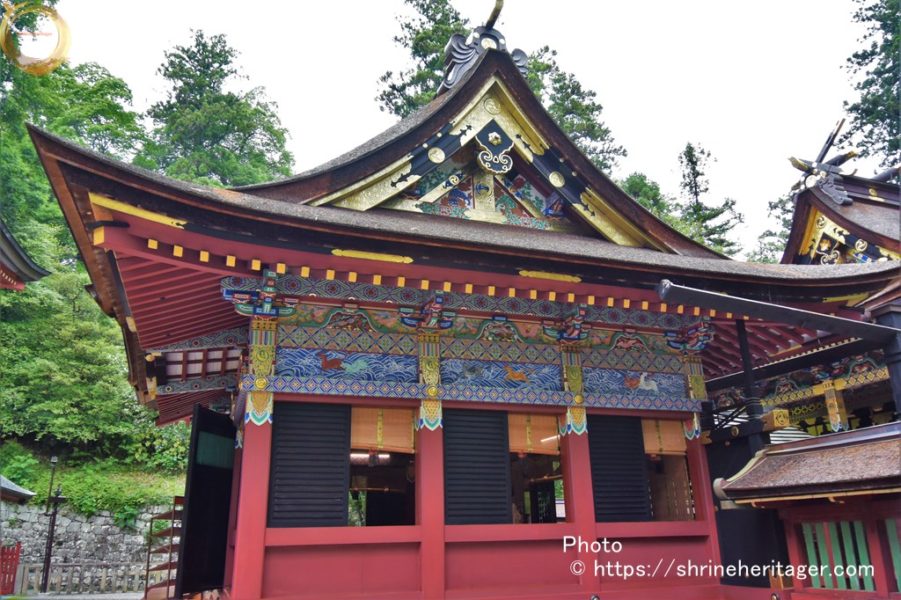
The main hall's architectural style is a unique single-story two-story building called Kanzenzo.
The interior of the building is on the second floor, and the upper part is equipped with a Kamiza.
It can be seen from the outside, but "Raijin small window" (the second floor part in the center of the front of the main hall) is provided toward the direction of Mt. Ina., the front of the main hall.
Look up at the shrine from left and right.
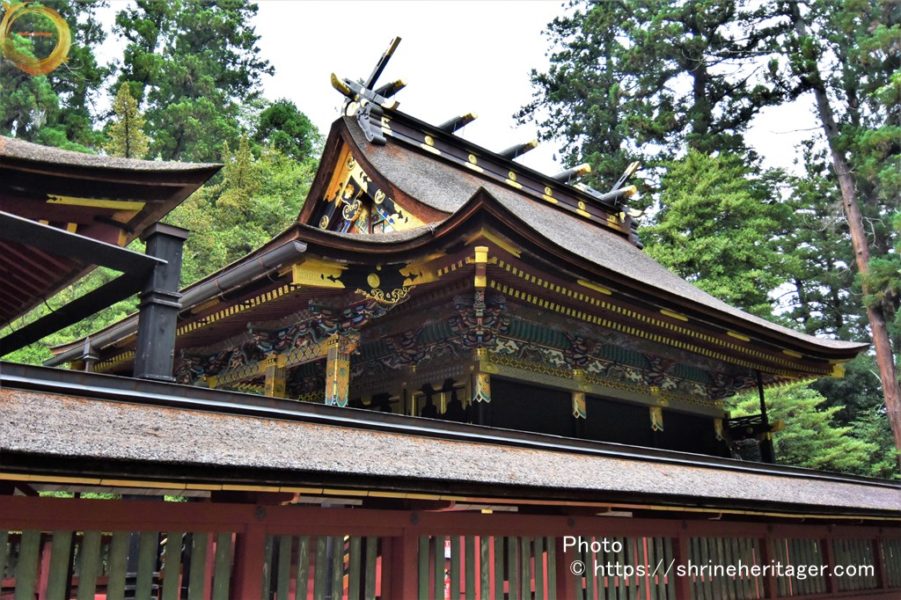

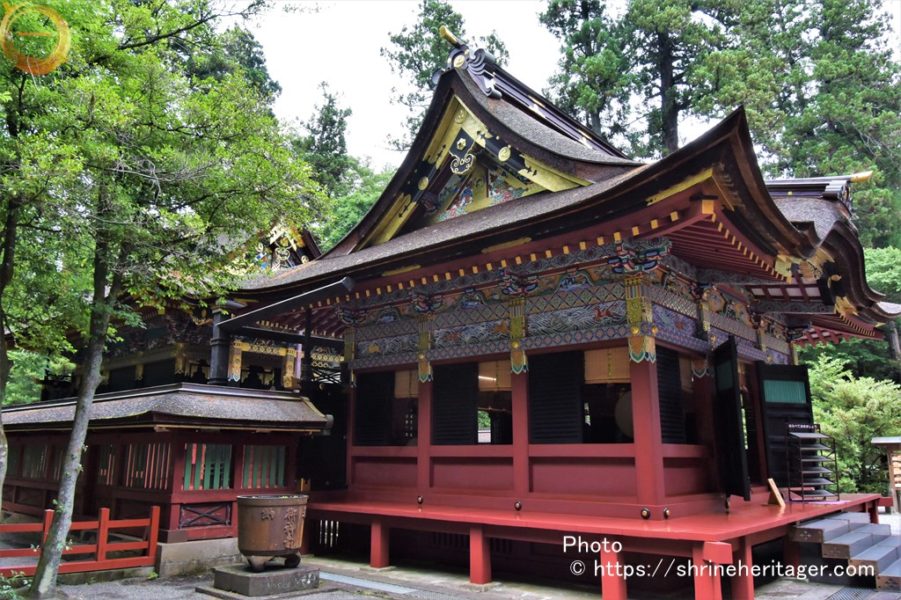
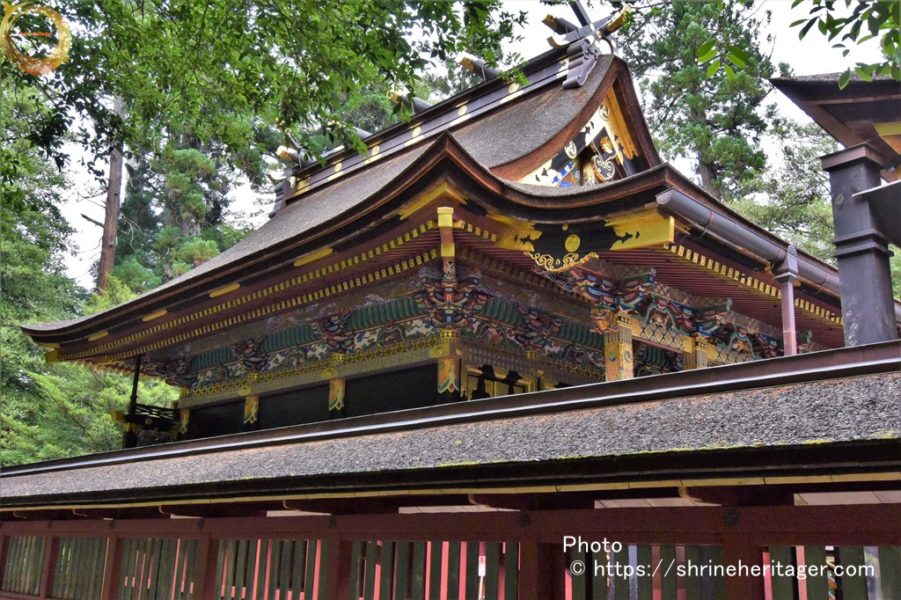
I can't get close to the outside of the wall on the left towards the main shrine, but there is a shrine in the precincts.
・抜鉾若御子神社(nukihokowakamiko shrine)
《主》経津主命御子
※元は一ノ宮字若宮に鎮座 明治38年に現在地に遷座
The 27th Generation of Emperor Ankan (531-535) was founded.
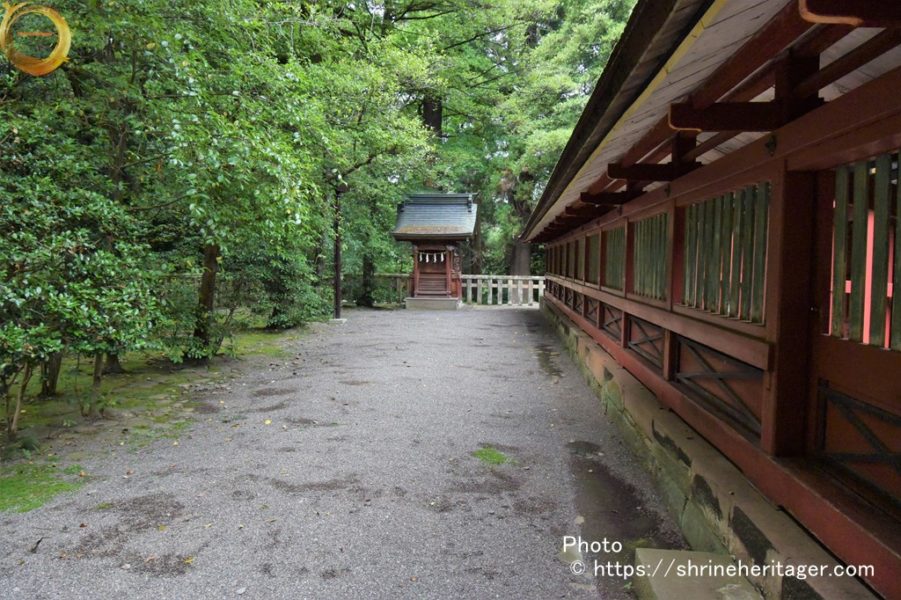
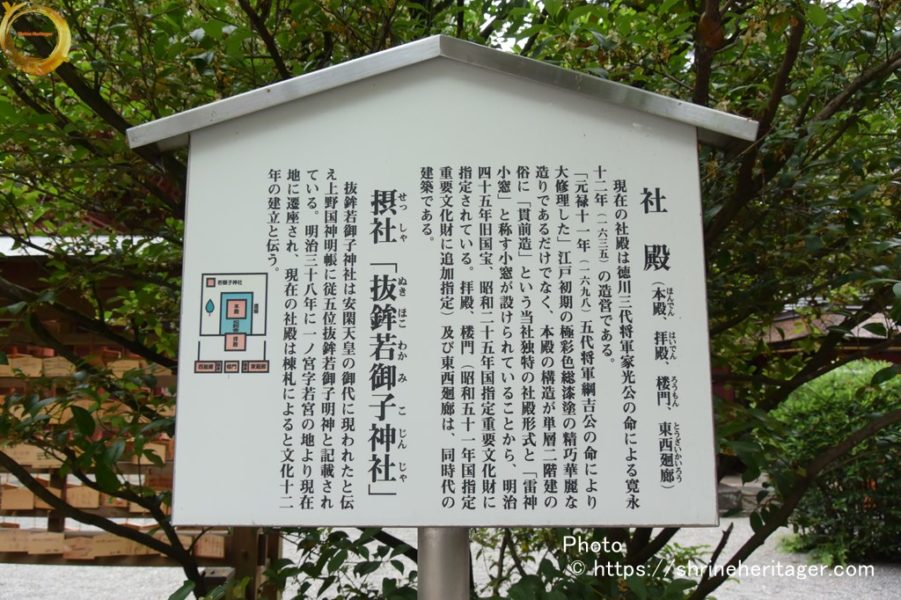
When you leave the one-end tower gate, there is a office and a god tag awarding place, and you will receive a seal etc.
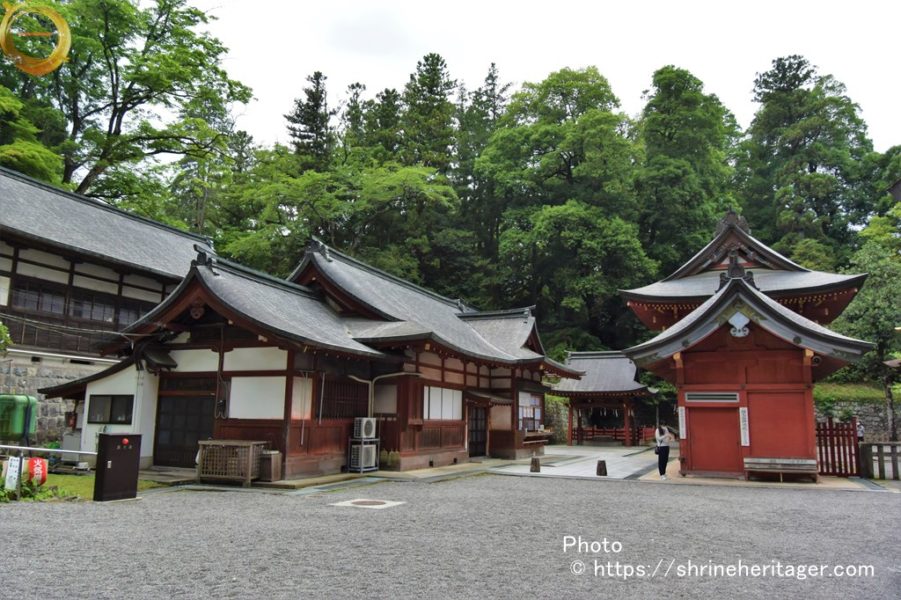
When I went clockwise around the shrine hall,
"Kagura-den" on the right
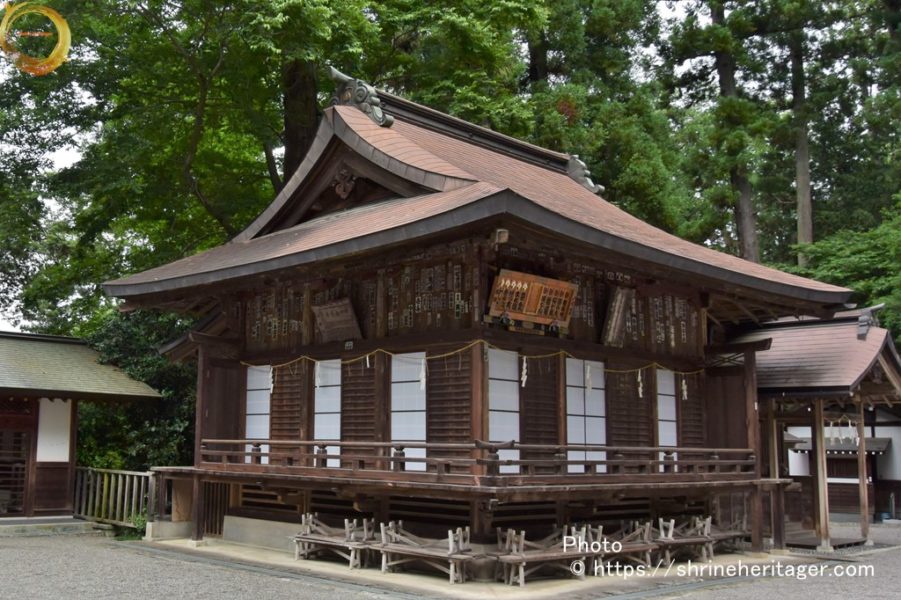
"Fujitasugi" in the back
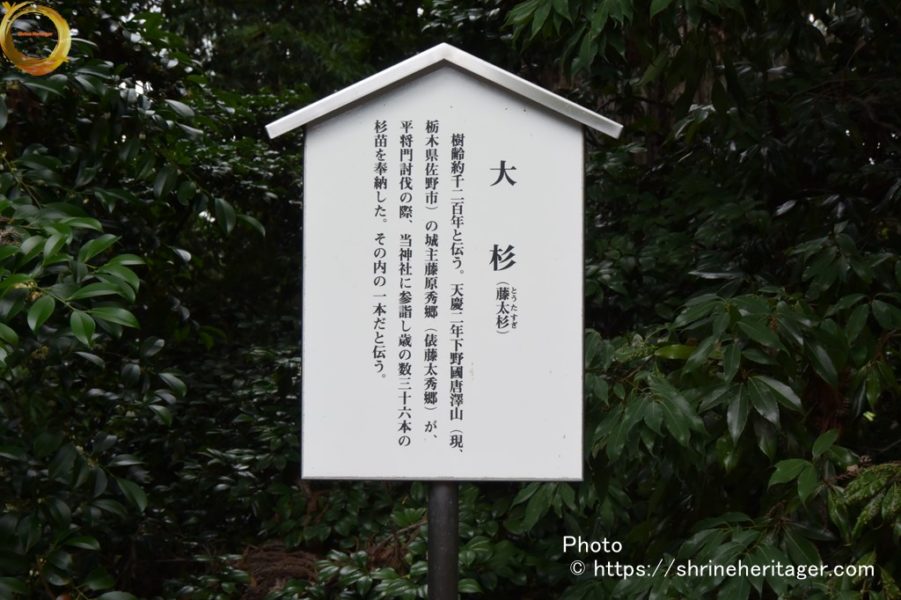
On the left is "Keizo Pass".
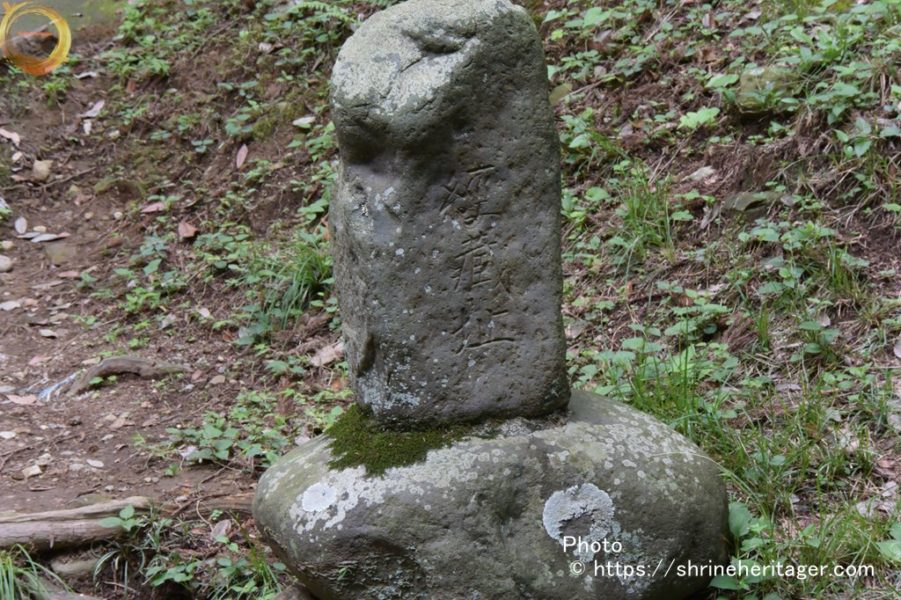
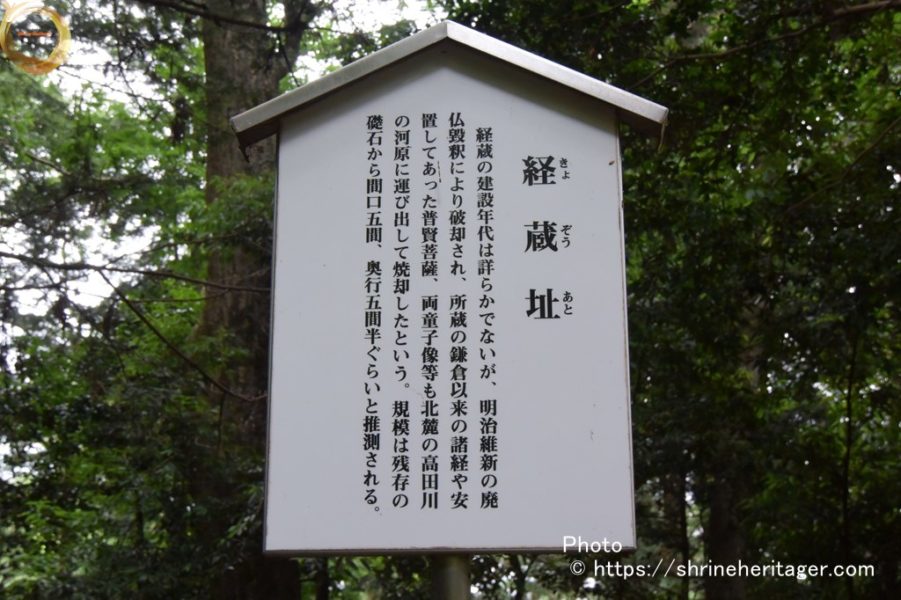
Look up at the main shrine from behind.
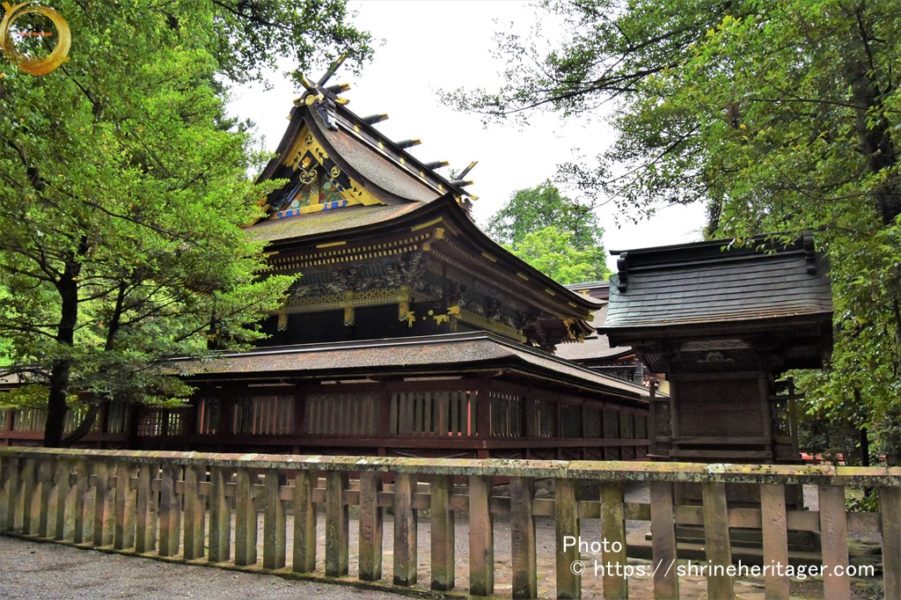
We're going back in front of the tower gate, passing in front of the well of the temizusha.
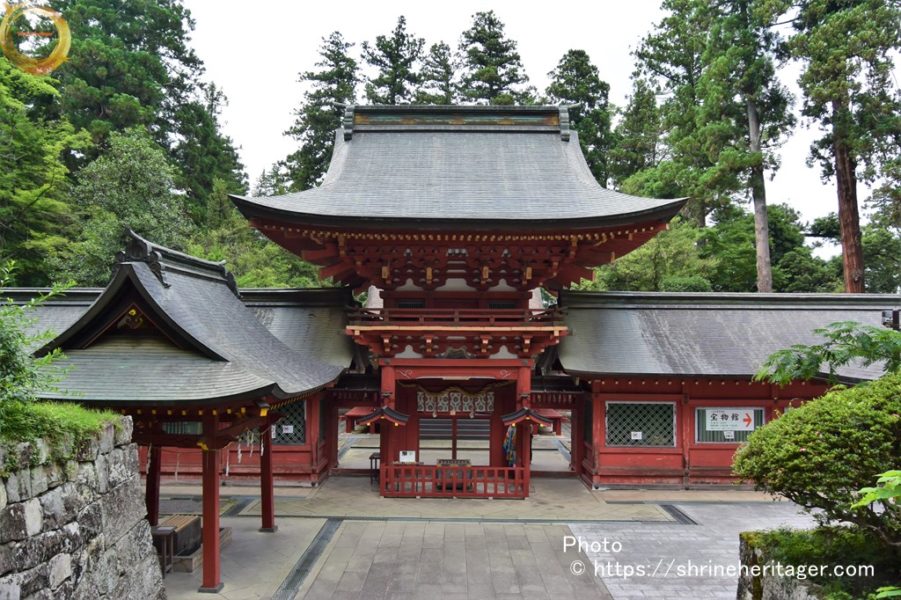
On the way back, it will be a stone step up to the main gate.
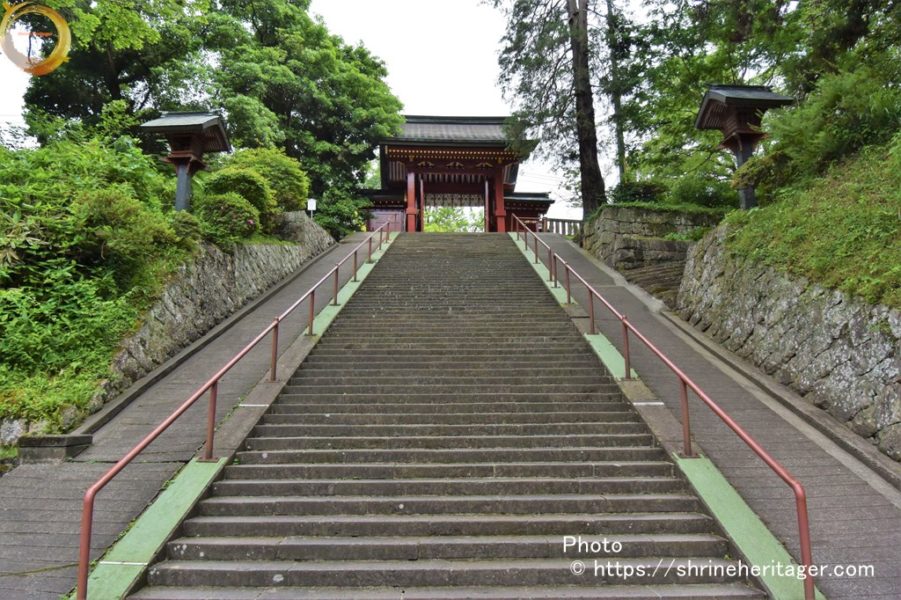
From the position where the lantern stands in the middle of the stone steps
Temporary Hall site (the ceremony year Sengu is held every 12 years at Kanzen Shrine, and a temporary hall is built on the temporary hall site), so the shrine sits down, so it is a pilgrimage.
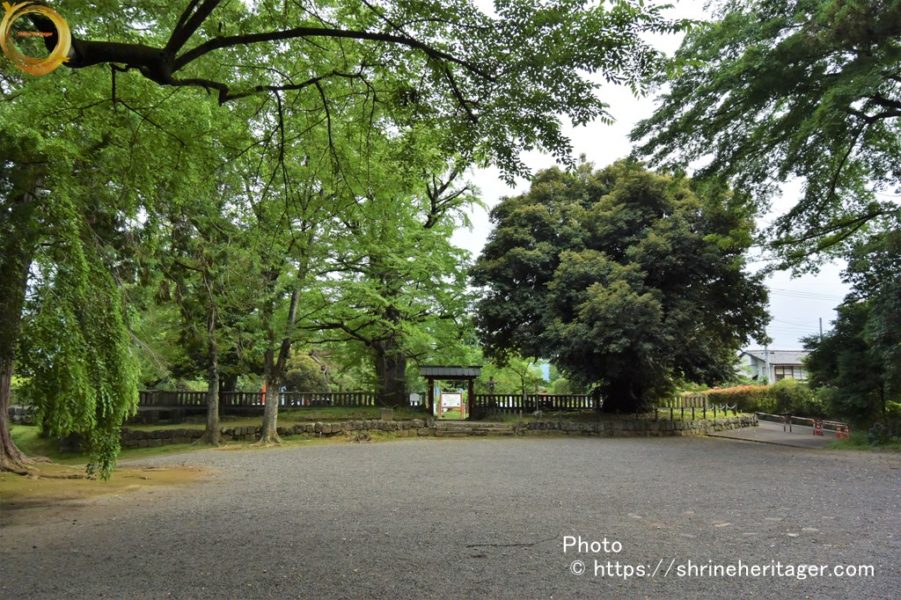
It is a arrangement map of the precincts of the temporary hall site.
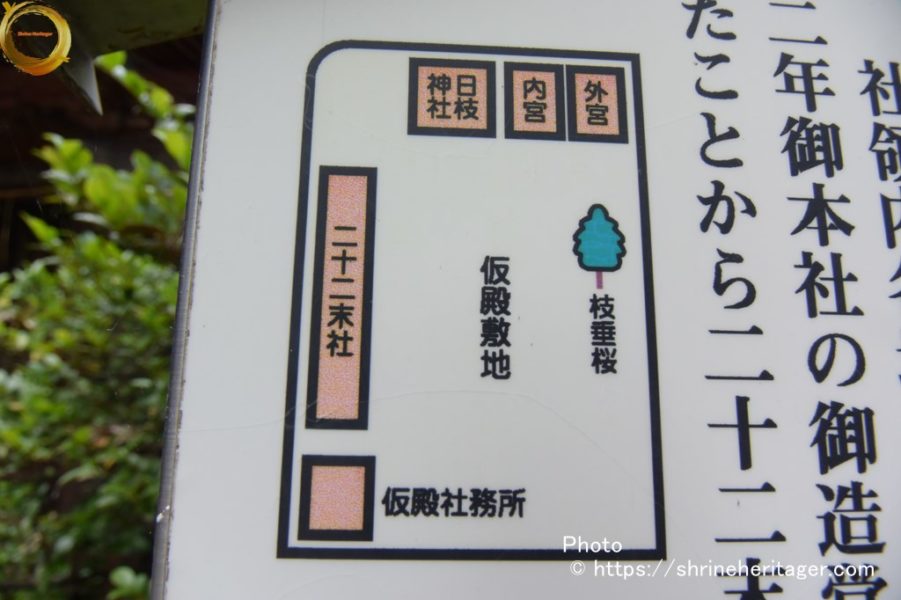
Sitting adjacent to the temporary hall site
・内宮(寛永12年 現在地に遷宮)
《主》天照皇大神
・外宮(寛永12年 現在地に遷宮)
《主》豊受大神
・日枝神社
《主》大己貴命・大山咋命
《合》建御名方命・八坂刀売命・豊受姫命・火産霊命・菅原道真公
稲倉魂命・木花咲耶姫命・伊邪那岐命・伊邪那美命・大物主命
宇迦之御魂命・波迩夜須毘売命・大山津見命・大日孁命
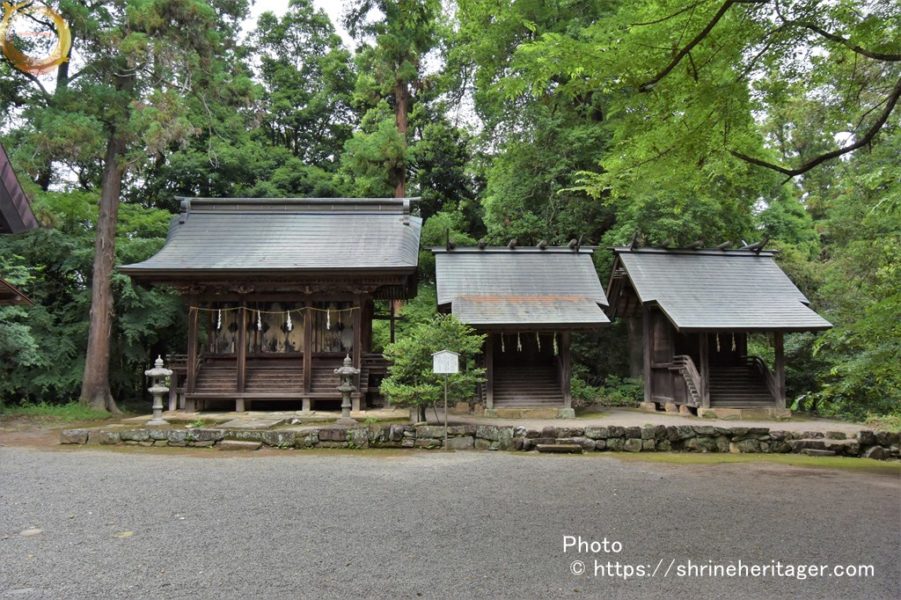
・二十二社
社領内に祀られていた各社を 寛永12年の造営時に一棟にまとめたと伝わります
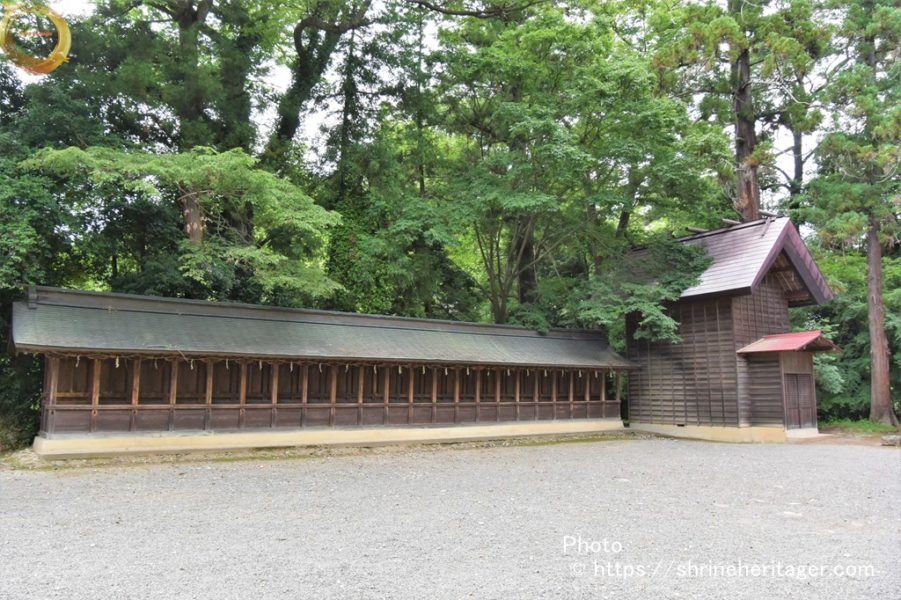
There is a "Stajii tree" of 1,000 years old, and it visits involuntarily.
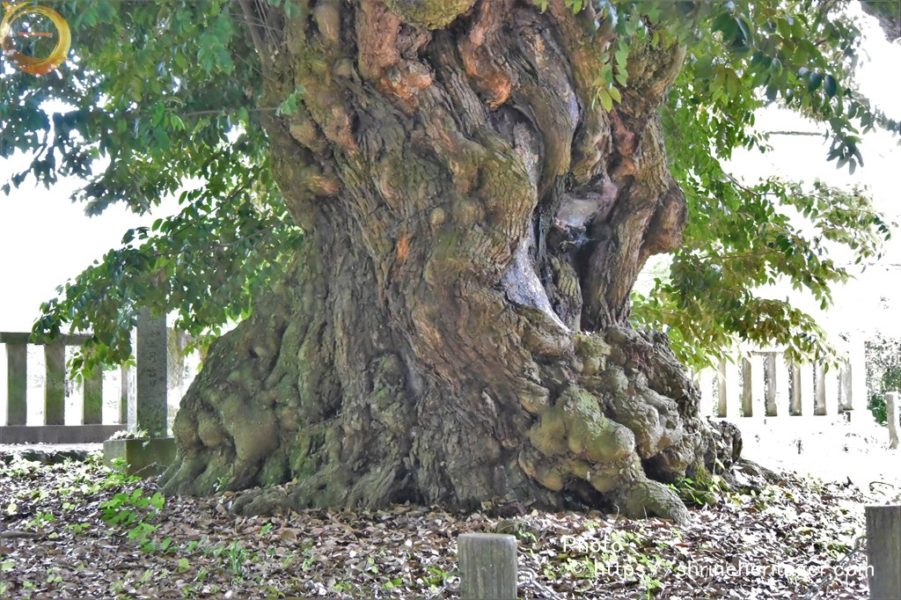
I'm leaving the precincts from the west gate.
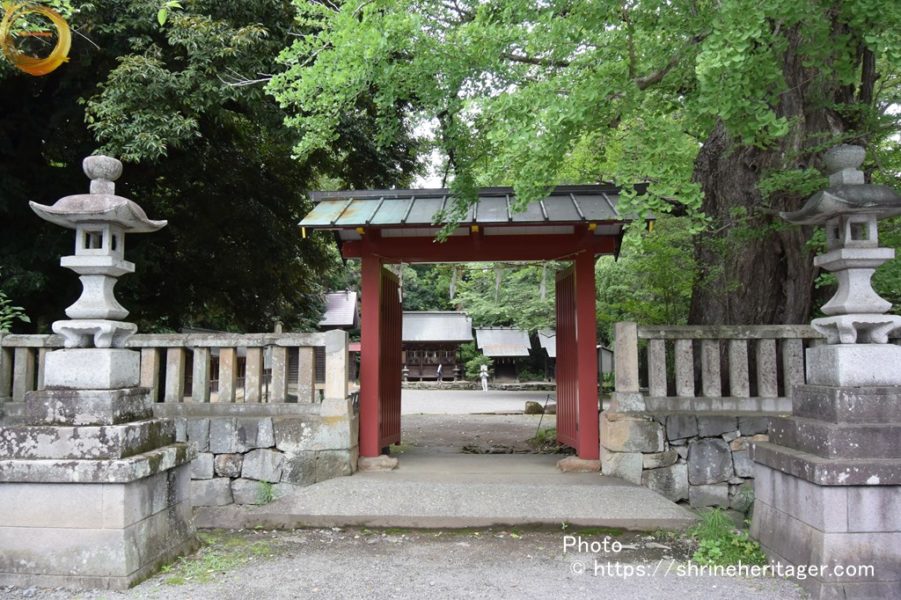
There's another gate.
It is called akazunomon, and it is a gate and torii gate set up at the time of the imperial envoy's visit.

Return to the front of the main gate and head to the Otorii Gate on the arcing approach.
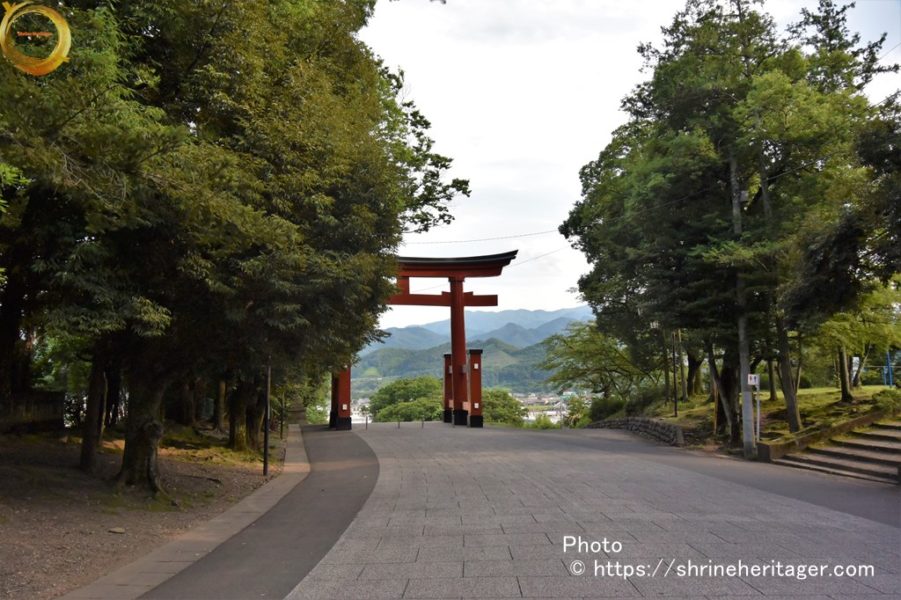
From the Otorii Gate, you can see Mt. Inagi in front of you and see the town of Ichinomiya.

スポンサーリンク
神社の伝承(Old tales handed down to shrines)
I introduce the thing related to this shrine and the literature described.
About the Sacred Floor in the History of the Six Kingdoms
Tradition written in "Tsuku Nihon Koku Kokuki"
The 54th Emperor Ninmei's reign (833-850) 18 years (869) Sadakan 11 years completed
『続日本後紀』承和6年6月(839)甲申条に
奉授について 上野国の「拔鋒神(貫前神社)」「赤城神(赤城神社)」「伊賀保神(伊香保神社)」と並んで無位から従五位下とあります
[Reference] National Archives Digital Archives "Continued Nihongoki" (869) Sadakan 11 years completion Winner: Fujiwara Ryobo / School revision: Tateno Spring Festival Kanmoto Hiromasa 2007 [former brewer] Ministry of the Interior
https://www.digital.archives.go.jp/DAS/meta/listPhoto?LANG=default&BID=F1000000000000047680&ID=&TYPE=&NO=
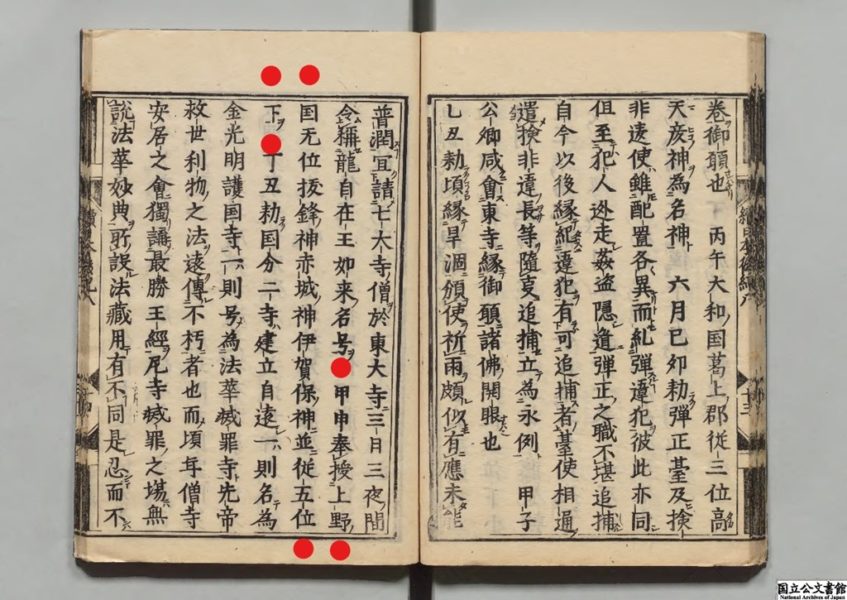
Tradition written in "Nihon sandai jitsoku"
平安時代(延喜元年(901年)成立)に編纂された歴史書 六国史の第六第56代 清和天皇・第57代 陽成天皇・第58代 光孝天皇
3代の天皇の御代 天安2年(858)8月~仁和3年(887)8月の30年間を扱う
『日本三代実録』貞観元年正月27日甲申条(859)に 上野国「貫前神(貫前神社)」正五位下勳八等から従四位下勳八等 と記されます
[Reference] National Archives Digital Archives "Nippon Sandai Jitsuroku" Enki 1st year (901) Approved by: Fujiwara Tokihei / School Revision: Matsushita Mibayashi Publishing Book (Aba) Hirofumi 13 years 20 books [former kurashu] Autumn leaves mountain paperback
https://www.digital.archives.go.jp/DAS/meta/listPhoto?LANG=default&BID=F1000000000000047721&ID=M2014093020345388640&TYPE=&NO=
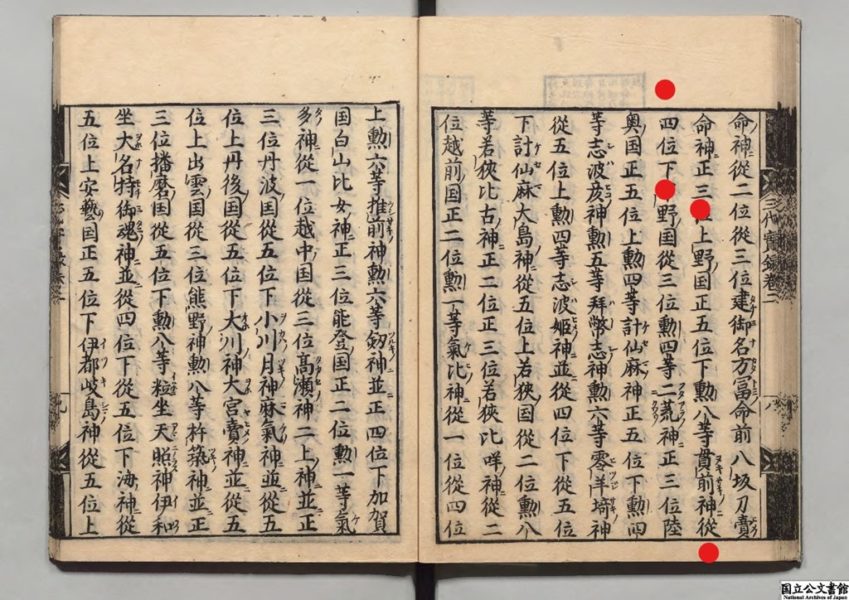
『日本三代実録』貞観9年6月20日丁亥条(867)に
上野国 従四位下勳八等「貫前神(貫前神社)」に従四位上勳八等
従五位上「赤城神(赤城神社)」「伊賀保神(伊香保神社)」並正五位下
従五位下「甲波宿祢神(甲波宿祢神社)」従五位上 と記されます
[Reference from the original text] National Archives Digital Archives [Japan Sandai Jitsuroku] source
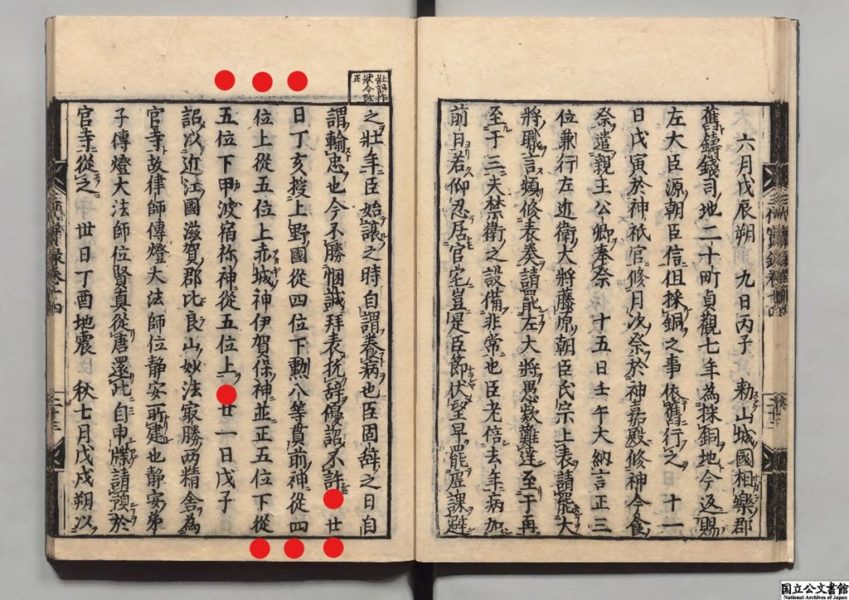
『日本三代実録』貞観18年4月10日丁巳条(876)に
上野国 従四位上勳八等「貫前神(貫前神社)」に正四位下
正五位上「伊賀保神(伊香保神社)」従四位下
正五位下「甲波宿祢神(甲波宿祢神社)」正五位上 と記されます
[Reference from the original text] National Archives Digital Archives [Japan Sandai Jitsuroku] source
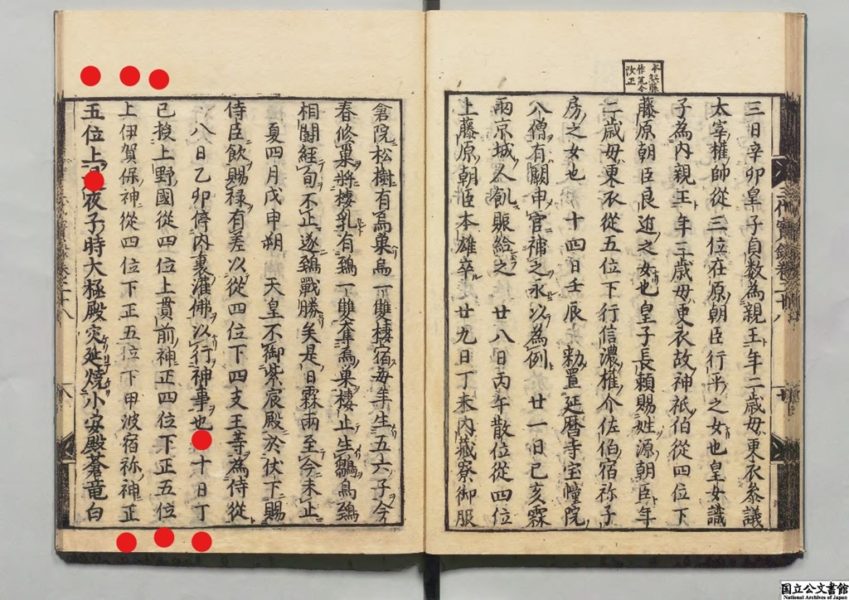
『日本三代実録』元慶3年閏10月4日庚寅条(879)に
上野国 正四位下「貫前神(貫前神社)」に正四位上勳八等
従五位下「波己曽神(波己曽神社)」「若伊賀保神(若伊賀保神社)」並従五位上 と記されます
[Reference from the original text] National Archives Digital Archives [Japan Sandai Jitsuroku] source

『日本三代実録』元慶4年5月25日戊寅条(880)に
上野国 正四位上勳八等「貫前神(貫前神社)」に従三位勲七等
従四位下「赤城石神」「伊賀保神(伊香保神社)」並従四位上
正五位下「甲波宿祢神(甲波宿祢神社)」従四位下
正五位下「小祝神(小祝神社)」「波己曽神(波己曽神社)」並正五位上勲十二等
従五位上「賀茂神(賀茂神社)」「美和神(美和神社)」並正五位下勲十二等
正六位上「稲裹地神(稲裹地神社)」従五位下勲十二等 と記されます
[Reference from the original text] National Archives Digital Archives [Japan Sandai Jitsuroku] source
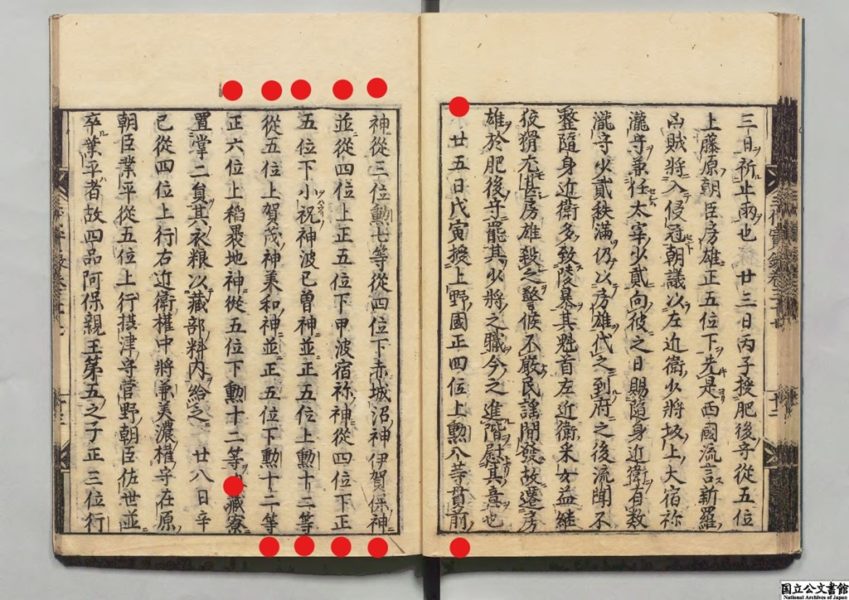
For worship, once go up the approach from the south side and go through the Otorii. A flat approach leads to the main gate, drawing an arc. Then, from there, there is a steep descending stone step, and the shrine is built right below. Up, flattening, and then down. Go to the shrine on a “down road” that is very rare in Japan.
貫前神社(nukisaki shrine)「拝 (hai)」(Bow down to 90 degrees)


